Text
Apple Car’s Crash: Design Details, Tim Cook’s Indecision, Failed Tesla Deal
By Bloomberg, Mar 6, 2023
Tim Cook shut down plans to acquire Tesla before cycling through a junkyard’s worth of self-driving designs over the past decade. The inside story is a case study in indecision.
Around the beginning of 2020, Apple Inc.’s top executives gathered at a former Chrysler testing track in Wittmann, Arizona, to try out the latest incarnation of the car the technology giant had been trying for years to make. The prototype, a white minivan with rounded sides, an all-glass roof, sliding doors and whitewall tires, was designed to comfortably seat four people and inspired by the classic flower-power Volkswagen microbus. The design was referred to within Apple, not always affectionately, as the Bread Loaf. The plan was for the vehicle to hit the market some five years later with a giant TV screen, a powerful audio system and windows that adjusted their own tint. The cabin would have club seating like a private plane, and passengers would be able to turn some of the seats into recliners and footrests.
Most important, the Bread Loaf would have what’s known in the industry as Level 5 autonomy, driving entirely on its own using a revolutionary onboard computer, a new operating system and cloud software developed in-house. There would be no steering wheel and no pedals, just a video-game-style controller or iPhone app for driving at low speed as a backup. Alternately, if the car found itself in a situation that it was unable to navigate, passengers would phone in to an Apple command center and ask to be driven remotely.
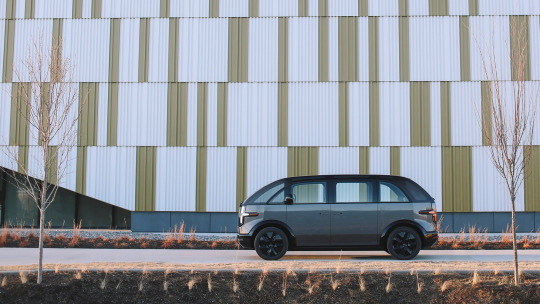
This Canoo electric van gives you a general idea of what the prototype car Apple tested in Arizona looked like. Apple’s was white, with whitewall tires and a sliding door.
In the Arizona desert, Chief Executive Officer Tim Cook, Chief Operating Officer Jeff Williams and senior members of Apple’s design team sat in the prototype as it drove itself around a test track. They loved what they saw. But there was a catch, as the car project’s head, Doug Field, made clear: A lot of work still needed to be done before the autonomous driving system would work in the real world. Field, who’d been hired away from Tesla Inc. to oversee the project, proposed scaling back the self-driving goals to Level 3, which requires a human driver to be ready to take over at a moment’s notice, not watching TV or FaceTiming in a backward-facing seat. But Field’s bosses wanted Level 5.
The next year, Field left Apple to take over the electric-vehicle and software engineering efforts at Ford Motor Co. Under Field’s successor, Kevin Lynch, who also runs Apple’s smartwatch software group, the car’s design continued to evolve. It had become pod-shaped, with curved glass sides that doubled as gull-wing doors, and the company considered including ramps that would automatically fold out to make heavy cargo easier to load. The front and the back were identical, and the only windows were on the sides, a design choice with potentially dire consequences in the event that a human needed to do any driving. (Front and rear windows were later added.) Some people on the project called it the I-Beam.
The I-Beam never made it into production, nor did any of Apple’s other designs. Now, it seems, they never will. On Feb. 27, Apple told staff it was giving up on developing a car. That decision, while abrupt, was not a surprise. Over the past decade, the company toiled away on at least five different major designs, drove prototype self-driving systems for more than a million miles, hired engineers and designers only to lay them off, and weighed partnerships or acquisitions with Tesla, Mercedes-Benz, BMW, Volkswagen and McLaren Automotive, among others. The car program cost, on average, roughly $1 billion annually (or nearly a fifth of Apple’s research and development budget a decade ago), with outside teams for chips, camera sensors, cloud services and software adding hundreds of millions of dollars more to the yearly spend.
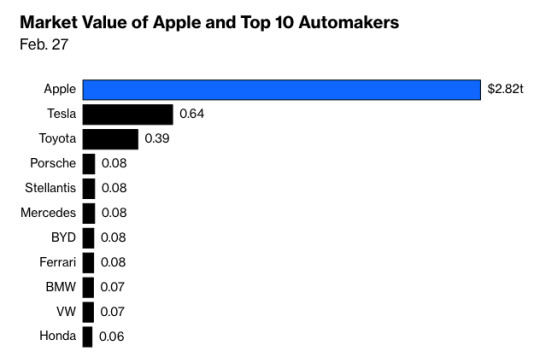
Source: Compiled by Bloomberg. Automakers are the 10 largest companies in the Bloomberg Intelligence Global Automobiles Valuation Peers group
But Apple never got close to realizing its original vision, or any of its subsequent ones. It didn’t get as far as testing a full-scale prototype on public roads. That it didn’t is partly thanks to the enormous technical difficulty of its self-driving goals, as well as the punishing economics of the automaking business. The project was also a failure, at the highest levels of the company, to settle on one thing and do it.
“There are a lot of roads you can take when you have a lot of really smart people and a very big budget,” says Reilly Brennan, a partner at the transportation technology venture fund Trucks VC. “But Apple never had the ability to make a bunch of specific decisions to lead them one way or the other.”
This story is based on conversations with several people involved in the development of the Apple car over the past decade, nearly all of whom asked to remain unnamed because the work was private. According to a longtime Apple executive who worked on the car, it was widely seen within the company as an ill-conceived product that needed to be put out of its misery. “The big arc was poor leadership that let the program linger, while everyone else in Apple was cringing,” they say. Asked what went wrong with the effort, a senior manager involved in the vehicle’s interior design replied: “What went right?”
What emerges is a portrait of the product development process at Apple today. The $2.6 trillion company has a history of hugely ambitious bets, and a track record of upending long-established businesses. It’s been a while since it did that, however. The iPhone is 17 years old and its sales declined last year, and newer products such as Apple’s watch and AirPods, while profitable, exist mostly in its orbit. The jury’s still out on the Vision Pro. Right now, the company is looking for its next big thing, and does not seem sure how to find it.

Cook, Jobs and legendary hardware developer Bob Mansfield, later a steward of Apple’s car project, discuss the iPhone 4 during a Q&A at the company’s headquarters in 2010.
It was Steve Jobs who first floated the idea of a car at Apple. In the late 2000s, in a typically grand pronouncement, the company’s co-founder and CEO declared internally that Apple should have dominant technologies in all of the spaces in which people spent time: at home, at work and on the go. For many Americans, being in transit means being on the road, sometimes for hours a day. “We talked about what would be this generation’s new Volkswagen Beetle,” recalls Tony Fadell, who led mobile device engineering under Jobs. In the wake of the 2008 financial crisis, with American car companies on the brink of failure, the Apple chief executive even floated the idea of acquiring General Motors Co. for pennies on the dollar.
That scheme was quickly abandoned, in part because Apple decided it would be a bad look and in part because of the need to focus on the iPhone. But in 2014, seeking a new multi-hundred-billion-dollar revenue stream, Cook began to focus again on cars. Apple executives weighing whether to enter the market joked with one another that they’d rather take on Detroit than a fellow tech giant: “Would you rather compete against Samsung or General Motors?” The profit margins in cars were far lower than in consumer electronics, but Apple was coming off a stretch during which it had reshaped not only the music industry but the mobile phone market. To its supporters, the idea of getting into automobiles had the potential to be, as one Apple executive puts it, “one more example of Apple entering a market very late and vanquishing it.” While the initial prototypes operated like traditional cars, these supporters eventually pursued more radical redesigns, invoking a transportation technology experience they said would “give people time back.” The ultimate plan was a living room on wheels where people who no longer needed to drive their cars could work or entertain themselves with Apple screens and services instead.
But before sketching out its own designs, Apple considered acquiring Tesla. At that point the electric-car maker’s success was far from assured, and its value was less than $30 billion, or a 20th of what it is today. Adrian Perica, Apple’s head of corporate development, held a series of meetings with Elon Musk. But Cook, who’d succeeded Jobs three years earlier, shut the deal down while negotiations were still at an early stage. Apple’s chief financial officer, Luca Maestri, formerly the General Motors CFO in Europe, argued that the car industry’s low margins were something the tech company couldn’t easily overcome.
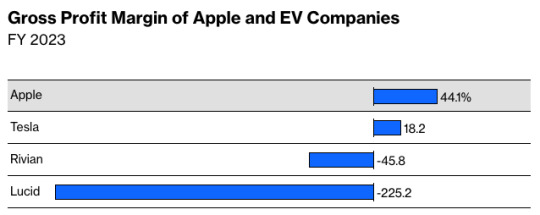
Source: Compiled by Bloomberg
Although the Tesla idea was abandoned, the ambitions didn’t go away. Apple’s newly minted hardware chief, Dan Riccio, received approval to start building a car engineering team, and he hired hundreds of engineers from the auto industry for what came to be known as Project Titan. The team working on the car was called the Special Projects Group. Within the company, it was difficult to find spare engineering talent, with attention focused on preparing for the upcoming Apple Watch release and, later, the iPhone X, but Riccio managed nonetheless to poach several dozen engineers from other projects. Early on, Jay Leno gave the team a tour of his garage for inspiration and a minor lesson in automotive history. Around this time, Riccio, rallying his troops, often would close with “Boys, let’s go build a car!”
The infighting began almost immediately. Maestri, the CFO, remained a skeptic, as did Craig Federighi, Apple’s software engineering chief, who had to donate personnel to what he considered a vanity project. Jony Ive, Apple’s design chief at the time, was more ambivalent, pushing for full driving autonomy but also expressing doubts about the wisdom of the endeavor. Some car fans on the Apple leadership team, including the company’s marketing executives, were resistant to building a product that didn’t look and feel like a car. Services head Eddy Cue suggested that it might be more prudent to just try to make a better Tesla rather than invent an entirely new category of machine.
Similar disagreements played out within Project Titan itself. Steve Zadesky, a former Ford engineer and iPhone executive in charge of much of the car effort, imagined the company starting off with limited self-driving features that could then be improved. Others held fast to Level 5. Perica, the mergers-and-acquisitions chief who’d pushed to buy Tesla, told the Apple car team that the company should build “the first bird,” not “the last dinosaur.” When the group first began staffing up in 2015, the goal was to bring something to market by 2020.
Under Ive, the microbus design emerged. The interior would be covered in stainless steel, wood and white fabric. Ive wanted to sell the car only in white and in a single configuration so it would be instantly recognizable, like the original iPod he’d designed. At one point, the group briefly discussed a more traditional SUV-like design, as well. The team’s secret facility in Sunnyvale, California, was packed with car cabin prototypes and simulators. “It looked like you entered Disneyland—it was chock-full of toys,” says someone who worked in the building.
The team played with several different ideas for the interior, including installing a pair of specialized touchscreens suspended with brackets from the ceiling to control the car from both sides of the cabin. It also engineered microphones to be placed outside the vehicle to bring external sounds into the cabin, something passengers in non-Apple cars did by rolling down a window. “They would add all sorts of crazy features to the car and then realize those were bad ideas and pull them back out, leading to another cockpit redesign,” says an Apple executive with knowledge of the frequent changes.
Throughout much of the process, Apple continued exploring partnerships. Riccio and Zadesky, years after Cook shot down buying Tesla, met with Musk to discuss ways they could collaborate, including the possibility of Tesla producing batteries for the Apple car. That prospect didn’t advance. Musk, who didn’t respond to a request for comment for this story, at one point publicly called Apple a “Tesla graveyard” full of engineers he’d fired. A few years later, he tried to restart talks with Cook as Tesla struggled to build the Model 3. Musk has said the Apple CEO wouldn’t meet.
Talks with Mercedes-Benz progressed further. For a few months, Apple and the German automaker actively worked on a partnership similar to the Tesla idea, but with a twist. Mercedes would manufacture Apple’s vehicle, while it would also sell its own cars with Apple’s self-driving platform and user interface. Apple eventually pulled out, in part because the early work gave its executives confidence they could build a car on their own, people involved in the failed deal say.
At other points, Apple held exploratory acquisition talks with car companies beyond Tesla. The closest it got to a deal was with McLaren. Some Apple executives believed that scooping up the British automaker, which makes a few thousand cars by hand each year and sells them to the super rich, would excite Jony Ive, who’d scaled back his involvement at Apple after the launch of the Apple Watch, and reengage him with the company. The proposed deal, before it fell apart, would have provided Ive with a new design studio in London. Other discussions with BMW AG and, much later, Canoo Inc.—an electric-vehicle startup with a decidedly Apple-esque design aesthetic—went nowhere.
By 2016, Apple hadn’t gotten far, and internal advocates of scaling back its car ambitions began to win out. After the board of directors and senior executives began questioning the program’s viability and asking pointed questions about its costs, there were discussions about shutting down the project. But then Riccio convinced Bob Mansfield, a legendary figure at the company for leading the hardware development of the original MacBook Air and iPad, to come out of semi-retirement to shake things up.
Mansfield was among the car skeptics at Apple. His task, as he saw it, was to find out what could be salvaged from the effort. After a few months of evaluation, he decided to focus more attention on the self-driving system than on a car itself. Autonomous software, he argued, could benefit Apple in other areas, even if the company never made an actual vehicle. Other executives, notably Perica, thought Apple could license such an AI system to other carmakers without dirtying its hands in the auto business itself. Over an 18-month period from 2016 to mid-2018, Apple laid off about 120 people, a significant portion of the car project’s head count, according to people with knowledge of the cuts.
FieldPhotographer: Ulysses Ortega
Before Mansfield persuaded Field, the former Tesla executive, to take over for him, he and Cook did manage to agree on an interim direction for the company’s autonomous driving efforts: a self-driving shuttle made in collaboration with Volkswagen for Apple employees to use at its new headquarters in Cupertino, California. That project didn’t come to fruition, either. It was seen as a distraction, and Field shut it down. He also eventually shuttered Apple’s work on batteries and other components he felt Apple could just buy off the shelf.

Field - Photographer: Ulysses Ortega
Under Field, full autonomy continued to be a focus even as it grew to seem less attainable. The Arizona demonstration, which the team spent nine months preparing for, was essentially a proof of concept. The team tweaked the prototype software to take turns and curves slower than usual, to make extra sure it wouldn’t injure Cook. “It was well scripted and well laid out,” says someone involved in its creation. “The intent was to show Tim that if we built this product, this is what it would look like for the customer.” (Apple bought the Arizona test track outright a year after the demo.) The team spent a lot of time working on backup controls for such a car so that a driver could extract it from tricky road situations, such as a complex construction zone. The most fully developed steering wheel substitute looked like the controller that comes with an Xbox. “It should have been either all autonomy or a wheel and pedals,” one person involved in the car’s development says, adding that the company spent a lot of time working on ways to mitigate the issue rather than on the hard problem itself.
There were other, smaller dead ends over the course of the project. Apple started planning a multi-acre engineering campus in Silicon Valley where it would design cars, but never broke ground. At one point, Apple and Ford met to discuss a proposal from the American automotive giant to sell Apple cars from its Lincoln brand, an unglamorous make that’s well-represented in rental fleets, to test the self-driving system. The talks didn’t progress past an early meeting.
For Field, Mansfield and others on the team, Cook’s indecision was frustrating. “If Bob or Doug ever had a reasonable set of objectives, they could have shipped a car,” says someone who was deeply involved in the project. “They’d ask to take the next step, and Tim would frequently say, ‘Get me more data, and let me think about it.’” In that setting, it was hard to retain talent: engineers Apple hired for the project would grow convinced things weren’t going anywhere and find jobs elsewhere. After Mansfield retired, the company tried another leadership change to boost the self-driving system. It put Williams, the COO, and John Giannandrea, Apple’s machine learning chief, in charge of overseeing Field and the project. Field left a year later, in September 2021.

Bloomberg News reported on this photo of a Lexus SUV equipped with early Apple self-driving technology back in 2017. Source: Bloomberg
Under Lynch, Apple never got to a streetworthy prototype. The self-driving technology in the company’s fleet of customized Lexus SUVs did show enough promise that there were plans to expand it to more cities in late 2024, according to people with knowledge of the plan. The idea had always been to sell self-driving as a subscription service, as Tesla does with its driver-support features. Other paid add-ons, such as Apple Music and Apple TV+ streamed to the vehicle, would help make up for the uninspiring margins on car hardware. (Some internal estimates pegged Apple’s cost to produce the car at about $120,000, far more than the $85,000 the company had wanted to charge for it.)
Last year, Apple pivoted one last time. Designs were tweaked to move from Level 5 down to Level 2, the level of Tesla’s current Autopilot, which can control both speed and steering but is assistive technology for drivers rather than their replacement. In keeping with that, the new design also incorporated a more traditional automotive interface: a steering wheel and pedals. “They finally smartened up,” says an Apple executive. “I was like, ‘Guys, you could have done this 10 years ago!’”
But the company had ended up where it began a decade earlier, with a product little different from what was already on the market and a basic, not-great self-driving system. “Kevin Lynch is a sensible person,” says an Apple executive involved in the car decision making. “He tried to bring a pragmatic view to it.” When asked, he made clear that true autonomy might be another decade off. He seems to have finally convinced Apple’s leadership that that was a problem without an affordable or reliable solution in the foreseeable future.
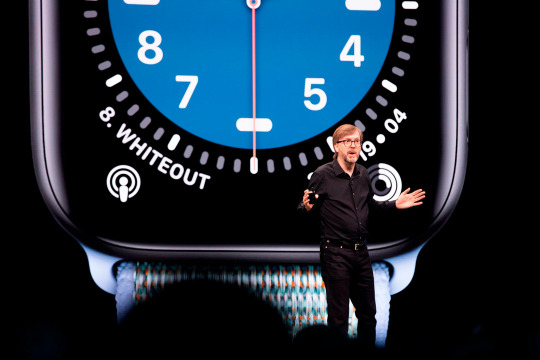
Lynch delivering the keynote address at Apple’s Worldwide Developer Conference in 2019.
Recently, members of the Apple car organization were studying how the company would produce the less-advanced car. It considered working with Magna International Inc., which builds some models for Jaguar, BMW and Mercedes. But the indecision at the top of the company filtered down, sapping morale. Apple declined to comment for this story, as did BMW, Ford, McLaren and VW. The former Apple executives named in this story didn’t respond to requests for comment. Neither did Canoo or Mercedes.
Around the beginning of 2024, Cook, who’s known for making decisions based on consensus, began seriously considering shutting down the project. “That’s when you started to see members of the leadership of Titan look for jobs at other companies and within Apple,” says someone with knowledge of the matter. People working on powertrains and other car-related engineering products began to depart.
On the evening of Monday, Feb. 26, the roughly 2,000 employees of Apple’s Special Projects Group received an email announcing a 10 a.m. all-hands meeting the next day. On Tuesday morning, the employees gathered in conference rooms and at desks at Apple’s Silicon Valley offices were told that Project Titan was winding down immediately. Lynch and Williams broke the news on a video call, and they didn’t explain the decision.
The meeting lasted about 12 minutes. Both men thanked the staffers for their work and got straight to the reorg and layoffs. Some employees would immediately get shifted to Apple’s AI division, and some would move over to software engineering. A chunk of the team, though, was immediately without a job. Hardware engineers would have the opportunity to apply for roles in other groups, but there aren’t spots for everyone. Other employees, such as the hundreds of car-specific engineers, test track technicians, self-driving car testers and automotive safety experts, received emails with their severance packages. As for the Arizona track, Apple is already working to sell it.
0 notes
Text
Jon Rahm’s Ryder Cup Future in Doubt After Speculation Grows Over £450m LIV Deal
By Telegraph, December 5 2023

No concrete agreement between Rahm and LIV but multiple sources tell Telegraph Sport they ‘expect’ Spaniard to join.
Jon Rahm’s Ryder Cup future has been thrown into doubt with speculation intensifying that he will imminently sign a record £450 million deal with LIV and join alongside another former world No 1 and one of Europe’s promising young players.
Multiple sources have told Telegraph Sport that they “expect” Rahm, the world No 3, to sign imminently and take control of his own team, although there is nothing concrete and LIV insiders insist that they remain in the dark concerning a capture which could maybe be considered as the breakaway’s most notable to date.
Another source informed Telegraph Sport that the Rahm negotiations are being led by the Public Investment Fund, the Saudi sovereign wealth fund which owns Newcastle United and this is the reason for the extreme secrecy within LIV.
As an example of the confusion one former Ryder Cup player on LIV told Telegraph Sport: “I think this will happen, and that Jason Day and Adrian Meronk” will also join, while another said, “I honestly know nothing and would just take everything as rumour if I were you”.
A well-placed character in the DP World Tour believes the Rahm announcement “could happen as soon as tomorrow (Wednesday) – if it happens”.
Meanwhile, Rahm’s camp continues not to answer queries, which inevitably only thrusts suspicions to new heights.
Furthermore, the absence of Rahm’s name was conspicuous at Tuesday’s launch for the Amex PGA Tour event in January. As defending champion, Tour custom dictates that Rahm will play at La Quinta – unless, of course, he had elected to play elsewhere.
The grapevine is beyond ripe with conjecture, perhaps greater than at any time since the LIV saga began two years ago. There are so many facets to be considered.
Connections between the timing of the Rahm rumours with the fact that PGA tour executive chief Jay Monaghan is due to meet next week with Yasir Rumayyan, the governor of the PIF, who is also chairman of Newcastle United, are difficult to escape.
This is being viewed as one of the definitive moments in the ongoing merger talks after the “framework agreement” that shocked the game in June. Since then, US investors have lined up to link up with the Tour, with whispers that the Saudis could even be locked out.
Rahm, who won this year’s Masters, played a leading role in Europe’s Ryder Cup triumph in Rome this year but joining LIV would put his future on Luke Donald’s team in doubt with fellow Europeans Sergio García, Lee Westwood and Ian Poulter being ineligible after joining the the Saudi breakaway league.
Would Rahm’s defection be the PIF’s warning?
“If Yasir goes in there with Rahm in his back pocket, he can look the PGA Tour in the eye and say ‘unless there is a merger then we will keep signing the big names’,” an insider said. “The Tour would be bullied into a corner.”
0 notes
Text
Not Taking Pictures of the Sistine Chapel
By Merlin and Rebecca, 26 March 2011
You can take pictures all throughout the Vatican Museums, except for inside the room that every one of the 4.5 million annual visitors are most likely there to see. I figured it wasn't allowed for security purposes. To keep the flow of traffic moving. However, it turns out that Nippon TV, a Japanese television company, funded the restoration of the chapel's frescoes in the 80s in exchange for exclusive photographic rights. Any book, postcard, print, etc wanting to depict the Sistine Chapel has to buy the copyright from Nippon TV. Talk about a good investment.

Signs like this were everywhere leading up to the Sistine Chapel. Be quiet. Don't fall down the stairs. No photography. Good thing they include that second one, because if someone actually did fall down the stairs, there's no way people would be able to remain silent - or refrain from taking pictures. This picture was taken right before entering, the closest our photo memories would come to capturing the famous work. Or so we thought.
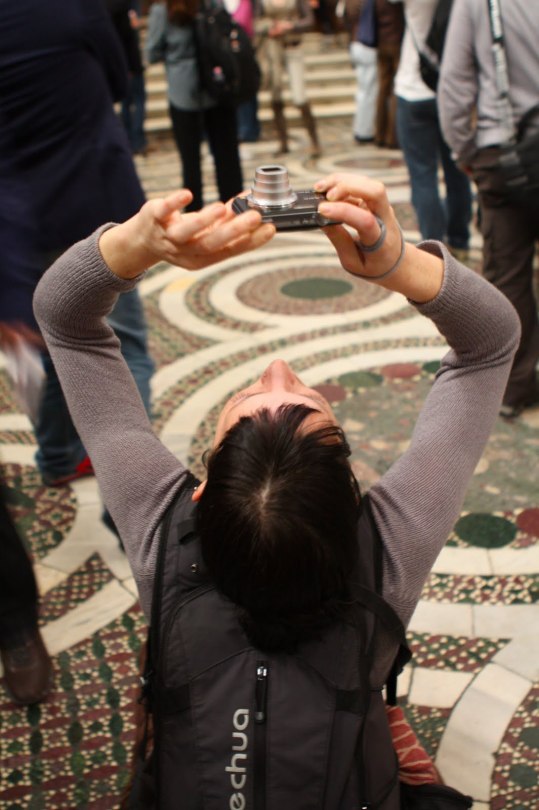
We've seen a lot of rule-breaking in the Vatican. Shorts, miniskirts, flash photography in the Basilica, photography of the Papal tombs. On our tour of the Excavations beneath St. Peter's (which was absolutely amazing), photography was prohibited. Yet, the tour in front of us each took turns flashing away at the box of Peter's bones. In the Sistine Chapel, though, it was particularly egregious. Guards just sat or stood there, not saying a word.
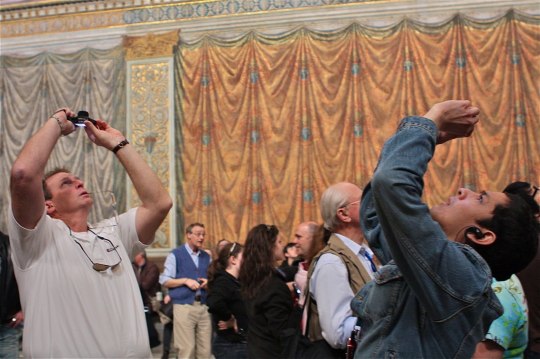
Just how lenient are the Vatican security guards? Well, just look at these people! Carla, our garden tour guide, told us that the man who attempted to assassinate Pope John Paul II was put in jail only because St. Peter's Square is technically under Italian jurisdiction. Had the crime taken place under Vatican City law, he would have just been forgiven and set free. That may have been an exaggeration... but I am inclined to think it wasn't.

Obviously, I decided to break the rules, too - but focused only on the tourists and not the work. It felt a little more honest that way. Plus, it's not like you need my photo to show you what one of the most famous works of art looks like. By the way, back when the pope was striking the copyright deal with Nippon TV, he apparently gave NBC a shot at it, too. They foolishly declined. How this fact hasn't popped up in an episode of 30 Rock, I'll never know.
End of article.
-
A message from nothingnothingaaa blog:
It is unclear over ten years on from the original writing of this article how lax or not these rules are now. Visit the chapel at your own risk, regarding your opportunity to photograph (or not) the famous ceiling.
As Mental Floss notes on their 2014 article:
"Yes, despite the rules that encourage quiet contemplation of the fantastic, eye-popping art that adorns nearly every inch of the walls and ceiling of the Sistine Chapel, visitors to the chapel will find their experience peppered with terse shouts of “No photo! No video!” from security guards.
The “No photos! No video!” rule remains in place for the Sistine Chapel (though as some recent visitors can attest, its enforcement isn’t exactly strict). Given the damage that can be caused by thousands of camera flashes going off in the chapel each day, it’s no surprise that Vatican officials decided not to end the ban when Nippon’s contract expired.
After all, the chapel houses some of the greatest art in the world—and a gift shop stocked with souvenir photos."
0 notes
Text
Every Actor Who’s Played Batman, Ranked from Worst to Best
By Insider, June 16 2023
10. GEORGE CLOONEY - BATMAN & ROBIN (1997); THE FLASH (2023)

George Clooney in "Batman & Robin." Warner Bros.
Still trying to find his footing post-"ER," Clooney was jumping back and forth between romantic comedies and action movies when he took the Batman role after Val Kilmer was one-and-done in "Batman Forever." It turned out to be a disaster. Fans were exhausted by director Joel Schumacher's colorful aesthetic and the cartoonish villains played by Arnold Schwarzenegger (Mr. Freeze) and Uma Thurman (Poison Ivy) fell flat. Plus, Clooney's Batman was too jokey turning the gruff Dark Knight into someone playful and soft. Back in 2013, Clooney said that he keeps a photo of himself as Batman to remind him how bad of a decision that was. However, the Oscar-winner had a little fun with his superhero status for "The Flash" as he appears as Bruce Wayne at the end of the movie, indicating that Barry Allen isn't in his universe.
9. LEWIS G. WILSON - THE BATMAN TV SHOW (1943)

Lewis G. Wilson in "The Batman" TV show. Columbia Pictures
Wilson has the distinction of being the first actor to play Batman starring in the 1943 series. Though he had the comics as a reference point, Wilson was still at a disadvantage being the first to put on the tights. He holds his own, but it's certainly not a performance that is memorable. Just take a look at him in the role.
8. ROBERT LOWERY - BATMAN AND ROBIN TV SHOW (1949)

Robert Lowery in the "Batman & Robin" TV show. Columbia Pictures
The second effort at a Batman TV series led to the casting of a bigger actor to play Batman. Lowery's physique and the show's better fight scenes make for a more enjoyable experience.
7. WILL ARNETT - THE LEGO MOVIE (2014); THE LEGO BATMAN MOVIE (2017); THE LEGO MOVIE 2: THE SECOND PART (2019)

Will Arnett voices Lego Batman. Warner Bros. Animation
It's tough to say whether Arnett has it easier or tougher having to do only a Batman voice to play the Lego version, but it's entertaining regardless. He voiced the character perfectly in "The Lego Movie," "The Lego Batman Movie," and "The Lego Movie 2: The Second Part."
6. BEN AFFLECK - BATMAN V SUPERMAN: DAWN OF JUSTICE (2016); SUICIDE SQUAD (2016); JUSTICE LEAGUE (2017); ZACK SNYDER'S JUSTICE LEAGUE (2021); THE FLASH (2023)
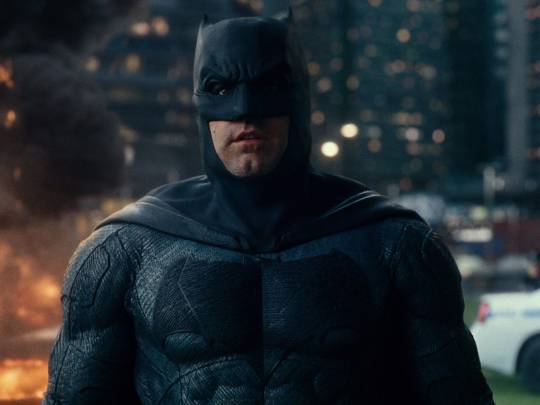
Ben Affleck in "Batman v Superman: Dawn of Justice." Warner Bros.
Most of the actors on this list had to deal with scrutiny when they agreed to take the Batman role. But you could arguably say Ben Affleck has had it the worst. Dealing with the social media hate that comes with being a superstar in today's world, Affleck had the cards stacked against him as soon as he was cast in "Batman v Superman." But he did well playing the character as brooding and past-his-prime.
5. VAL KILMER - BATMAN FOREVER (1995)

Val Kilmer in "Batman Forever." Warner Bros.
Having to replace Michael Keaton after he dropped out of making a third Batman movie, Kilmer came in with a smoother style, and audiences enjoyed it. The movie made more than "Batman Returns." It would have been interesting to see what would have happened if Kilmer had stayed on for another movie.
4. ADAM WEST - BATMAN TV SHOW (1966); THE FLASH (2023)

Adam West in the "Batman" TV show. 20th Century Fox
Love it or hate it, West's Batman portrayal is singular and permanently imprinted on many brains. He's the first image many of us have of the character (he's even Christian Bale's favorite Batman). West gave the character a squeaky-clean persona that was perfect for the kid-friendly show. The only knock on him: His fighting abilities were less than desired.
3. ROBERT PATTINSON - THE BATMAN (2022)
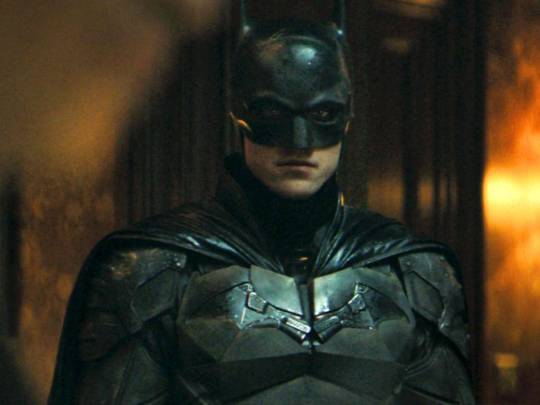
Robert Pattinson in "The Batman." Warner Bros.
Pattinson's Batman is still very rough around the edges as we focus on the character in his second year as Gotham's Dark Knight. And that's what makes it so appealing as instead of watching Bruce Wayne in his prime as a superhero here he's using his raw talent and desire to make Gotham better to get through every night. Also, Pattinson plays the character with such darkness and fury you can't take your eyes off of him.
2. CHRISTIAN BALE - BATMAN BEGINS (2005); THE DARK KNIGHT (2008); THE DARK KNIGHT RISES (2012)
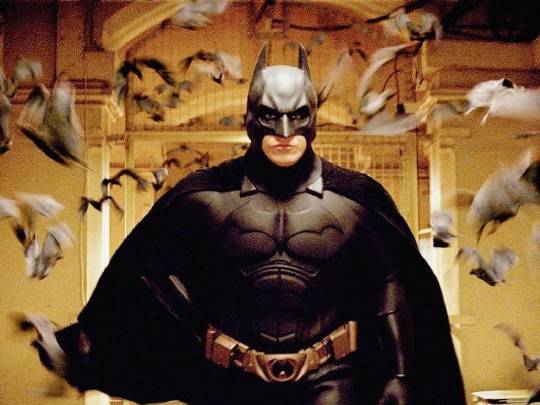
Christian Bale in "Batman Begins." Warner Bros.
Bale's acting chops and dedication to the characters he takes on are unquestioned, and he certainly delivered in the three times he played the character. The argument could be made that you could never understand Bale when he spoke as Batman or that he was helped heavily by the creative force that is director Christopher Nolan. Regardless, Bale brought an intensity to the character that had never been seen before.
1. MICHAEL KEATON - BATMAN (1989); BATMAN RETURNS (1992); THE FLASH (2023)
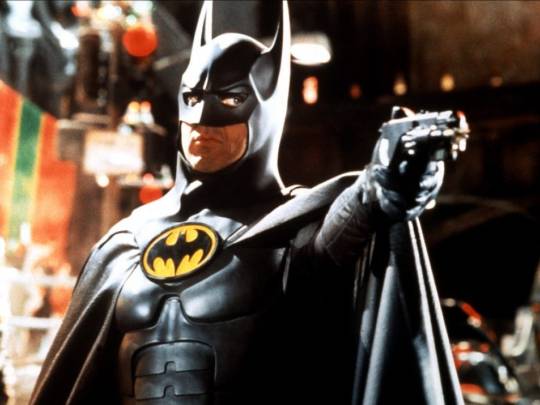
Michael Keaton in "Batman." Warner Bros.
The casting of Keaton is definitely up there as one of the biggest gambles a studio has ever made. Known best for his comedic work, Keaton faced a near-universal fan backlash when announced for the 1989 film. But Keaton proved everyone wrong, and along with director Tim Burton brought legitimacy back to a franchise that was on life support by then. Playing the character as dark and mysterious, yet still capable of a wry laugh, Keaton paved the way for how Batman would be seen for the decades to come. And decades later he reprised his role for "The Flash," once more proved he's the best Dark Knight as he's a major highlight of the movie. Keaton is so confident in his performance in the role that he can say, "I'm Batman." And you know what? We think he's right.
HONORABLE MENTION: WE CAN'T LEAVE OUT KEVIN CONROY

Kevin Conroy is the voice of the animated Batman. Warner Bros.
Though numerous actors have voiced Batman, there's one who stands out. Kevin Conroy has basically become "the voice" of the Dark Knight, doing the character for "Batman: The Animated Series" in the early 1990s and almost everything else related to Batman in animation and video games until his death in 2022. All hail to the G.O.A.T.!
15 notes
·
View notes
Text
The Tale of Peter Rabbit
Beatrix Potter, 1902

Once upon a time there were four little Rabbits, and their names were—
Flopsy,
Mopsy,
Cotton-tail,
and Peter.

They lived with their Mother in a sand-bank, underneath the root of a very big fir-tree.

'Now my dears,' said old Mrs. Rabbit one morning, 'you may go into the fields or down the lane, but don't go into Mr. McGregor's garden: your Father had an accident there; he was put in a pie by Mrs. McGregor.'
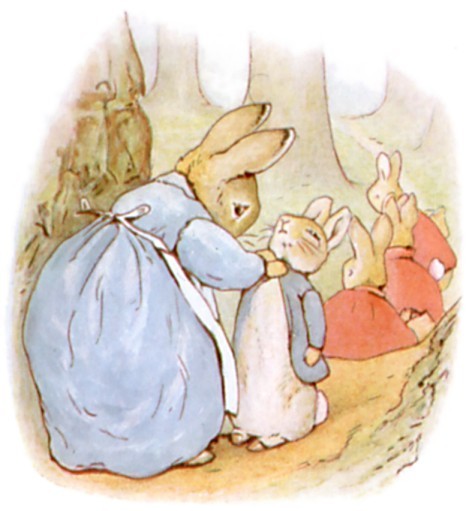
'Now run along, and don't get into mischief. I am going out.'
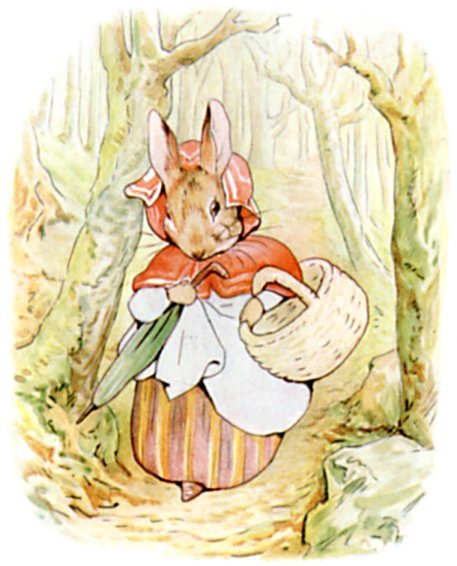
Then old Mrs. Rabbit took a basket and her umbrella, and went through the wood to the baker's. She bought a loaf of brown bread and five currant buns.

Flopsy, Mopsy, and Cotton-tail, who were good little bunnies, went down the lane to gather blackberries:
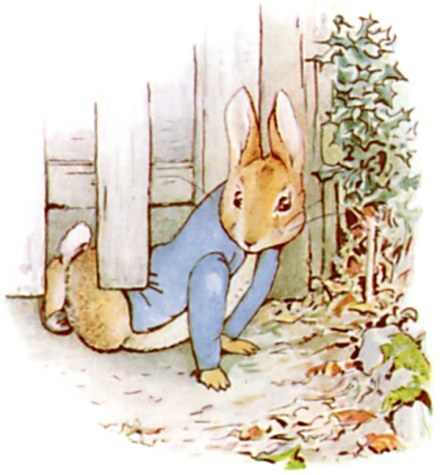
But Peter, who was very naughty, ran straight away to Mr. McGregor's garden, and squeezed under the gate!
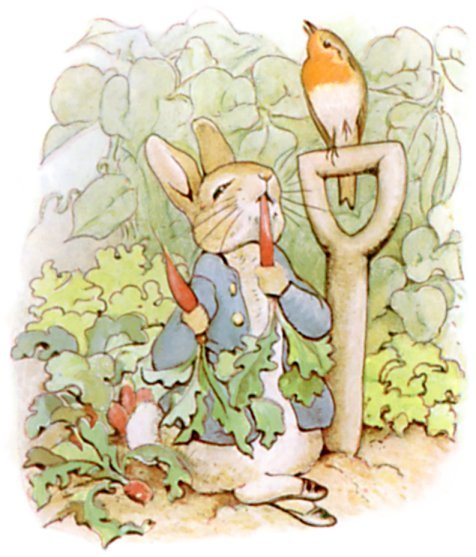
First he ate some lettuces and some French beans; and then he ate some radishes;

And then, feeling rather sick, he went to look for some parsley.
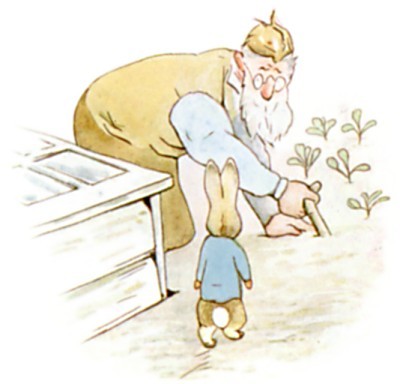
But round the end of a cucumber frame, whom should he meet but Mr. McGregor!

Mr. McGregor was on his hands and knees planting out young cabbages, but he jumped up and ran after Peter, waving a rake and calling out, 'Stop thief!'

Peter was most dreadfully frightened; he rushed all over the garden, for he had forgotten the way back to the gate.
He lost one of his shoes among the cabbages, and the other shoe amongst the potatoes.
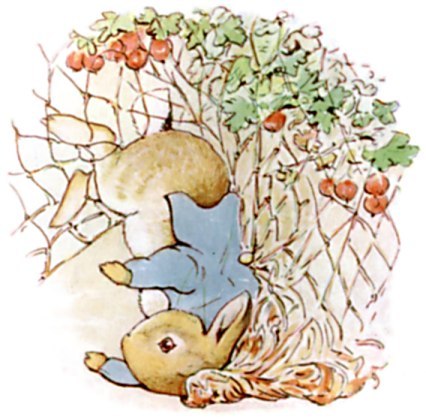
After losing them, he ran on four legs and went faster, so that I think he might have got away altogether if he had not unfortunately run into a gooseberry net, and got caught by the large buttons on his jacket. It was a blue jacket with brass buttons, quite new.

Peter gave himself up for lost, and shed big tears; but his sobs were overheard by some friendly sparrows, who flew to him in great excitement, and implored him to exert himself.
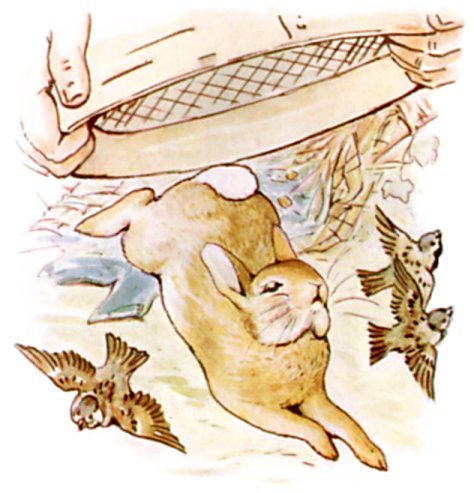
Mr. McGregor came up with a sieve, which he intended to pop upon the top of Peter; but Peter wriggled out just in time, leaving his jacket behind him.
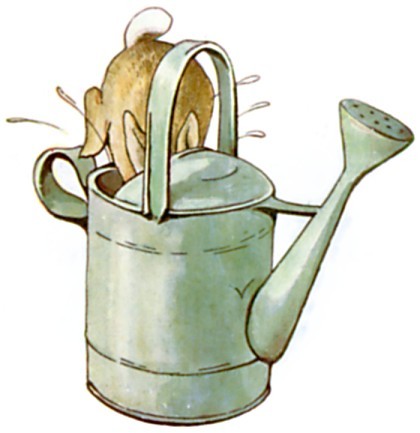
And rushed into the tool-shed, and jumped into a can. It would have been a beautiful thing to hide in, if it had not had so much water in it.
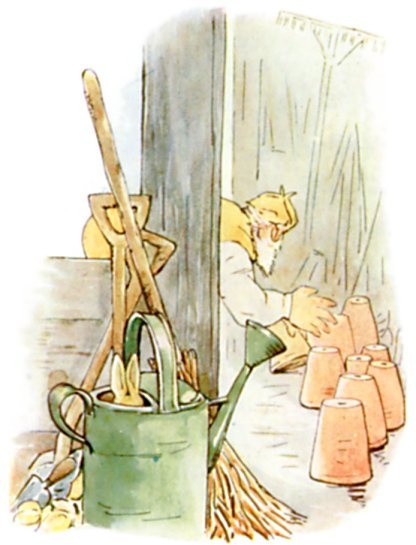
Mr. McGregor was quite sure that Peter was somewhere in the tool-shed, perhaps hidden underneath a flower-pot. He began to turn them over carefully, looking under each.
Presently Peter sneezed—'Kertyschoo!' Mr. McGregor was after him in no time.
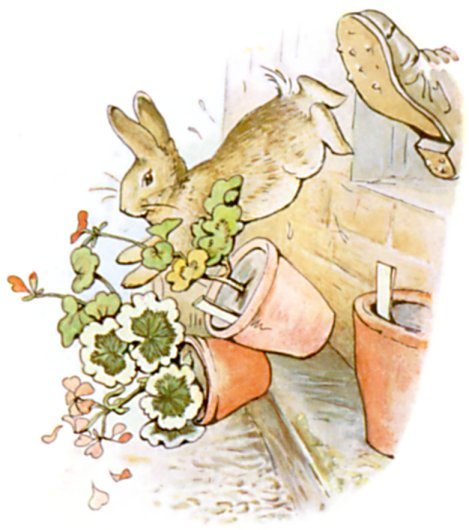
And tried to put his foot upon Peter, who jumped out of a window, upsetting three plants. The window was too small for Mr. McGregor, and he was tired of running after Peter. He went back to his work.

Peter sat down to rest; he was out of breath and trembling with fright, and he had not the least idea which way to go. Also he was very damp with sitting in that can.
After a time he began to wander about, going lippity—lippity—not very fast, and looking all round.
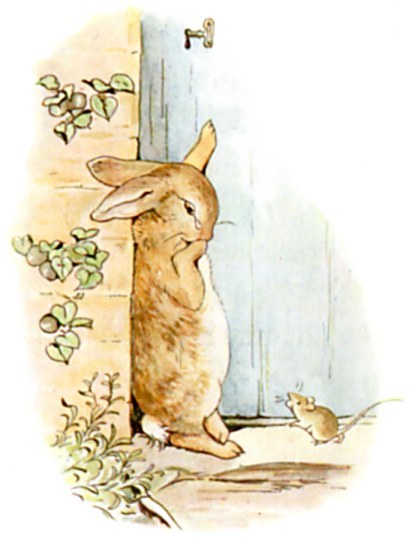
He found a door in a wall; but it was locked, and there was no room for a fat little rabbit to squeeze underneath.
An old mouse was running in and out over the stone doorstep, carrying peas and beans to her family in the wood. Peter asked her the way to the gate, but she had such a large pea in her mouth that she could not answer. She only shook her head at him. Peter began to cry.

Then he tried to find his way straight across the garden, but he became more and more puzzled. Presently, he came to a pond where Mr. McGregor filled his water-cans. A white cat was staring at some gold-fish, she sat very, very still, but now and then the tip of her tail twitched as if it were alive. Peter thought it best to go away without speaking to her; he had heard about cats from his cousin, little Benjamin Bunny.

He went back towards the tool-shed, but suddenly, quite close to him, he heard the noise of a hoe—scr-r-ritch, scratch, scratch, scritch. Peter scuttered underneath the bushes. But presently, as nothing happened, he came out, and climbed upon a wheelbarrow and peeped over. The first thing he saw was Mr. McGregor hoeing onions. His back was turned towards Peter, and beyond him was the gate!

Peter got down very quietly off the wheelbarrow; and started running as fast as he could go, along a straight walk behind some black-currant bushes.
Mr. McGregor caught sight of him at the corner, but Peter did not care. He slipped underneath the gate, and was safe at last in the wood outside the garden.

Mr. McGregor hung up the little jacket and the shoes for a scare-crow to frighten the blackbirds.
Peter never stopped running or looked behind him till he got home to the big fir-tree.
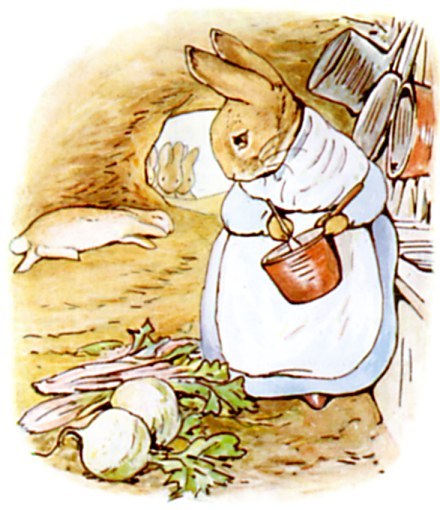
He was so tired that he flopped down upon the nice soft sand on the floor of the rabbit-hole and shut his eyes. His mother was busy cooking; she wondered what he had done with his clothes. It was the second little jacket and pair of shoes that Peter had lost in a fortnight!

I am sorry to say that Peter was not very well during the evening.
His mother put him to bed, and made some camomile tea; and she gave a dose of it to Peter!
'One table-spoonful to be taken at bed-time.'

But Flopsy, Mopsy, and Cotton-tail had bread and milk and blackberries for supper.
THE END
1 note
·
View note
Text
RFK Jr. on guns [twitter spaces transcript]:
My decision on the gun-control is I’m not going to take away anybody’s guns. I’m a constitutional absolutist. You know, we can argue about whether the second-amendment was intended to protect guns, but that argument has now been settled by the Supreme Court. And the Supreme Court and Antonin Scalia’s decision is a very expansive interpretation of the right to own a gun. But more importantly anybody who tells you that with incremental changes, with incremental laws in regulating guns… and by the way I want to say this: I have two members of my family that were killed in gun-violence. I understand the heartbreak that this is causing to so many Americans—it’s touched my family directly, and I know as President that you’re going to expect me and I’m going to everything I can to reduced gun-violence in this country. I think one of the tools that has been taking out of my hands is taking away people’s guns.
I don’t think it’s the right thing right now because it would just polarise our country. I’ve lived in rural areas of this country. I know how integrated gun-culture is in those areas and I know how important it is to them in the way they view the constitution. I know we’re living in a time where the constitution has been under attack. All the amendments in an unprecedented way and how that would be seen by people who believe strongly in the second amendment as part of a systematic assault on our Bill of Rights. And I don’t want to get into that debate. I want to stop the school shootings and if it comes down to protecting the schools the way we do airlines I will do that. I do not want any more children dying in our schools. I also am going to look very closely at the role of psychiatric drugs in these events, and there are no good studies right now that should have been done years ago on this issue, because there’s a tremendous circumstantial evidence that those SSRI’s and benzos and other drugs are doing this.
There is something happening in our country right now that is not happening anywhere else in the world and has never happened in human history. And you have to look at some of—almost all of these drugs. If you look at their manufacturer’s inserts they include a side effect of homicidal and suicidal behaviour. And prior to the introduction of Prozac we had almost no—none of these events in our country and we’d never seen them in human history where people walk into a schoolroom of children or strangers and start shooting people. There’s other nations that have as many guns per capita as we do, like Switzerland [inaudible] where the last school shooting was 21 years ago. We have one every 21 hours.
The one thing that we have that’s different than anybody in the world is the amount of psychiatric drugs our children are taking, and our people are taking. And we need to look at that and NIH should have done that years ago, but they will not do it and they’ll block other people from doing it because they’re working not for us but for the pharmaceutical industry, and this is their major profit center today, and so nobody wants to hear—none of those—Pharma does not want to hear about any problems with SSRI’s. But I will do those studies immediately when I get into office and we’re going to get to the truth.
Something is… you know, the proliferation of guns clearly abet violence, but anybody who tells you that they can remove enough guns; AR-15’s or whatever, but tinkering at the margins and get to the kind of situation that they have in western Europe is pulling your leg; it’s not going to happen. We need to look now at other solutions and the only way we’re ultimately going to get gun controls in this country is through consensus and that consensus cannot happen when we’re all at each other’s throats.
We need to assure the public; people who feel insecure about the Constitution, that our Constitution is no longer under threat; that nobody wants to come and take away their guns. And that will bring people to the table, and say ok how do we protect our children. And that’s what I’m gonna try to do as President.
0 notes
Text
Real World Range Tests for All Three BMW i3 models¹
2015, 18.2 kWh battery (60Ah) Rex² was 76 miles on battery… or 169 miles including Rex.
2018, 27.2 kWh (94Ah) was 131 miles on battery… or 224 miles including Rex.
2020, 37.9kWh (120Ah) battery-only model was 173 miles on battery (this model has no Rex).
Pure highway/motorway driving may result in decreased range.³

¹All testing personally driven by RSymons in the UK (on YouTube). Testing reflects real world mixed driving.
²Rex or range-extender i3 models have a 650cc 2-cylinder petrol engine. Additionally worth mentioning is the fact that the US range-extender model fuel tank is said to be smaller than the one in Europe, 7 litres and 9 litres respectively. RSymons' numbers reflect the larger tank.
³Bjørn Nyland (on YouTube) separately got 160 miles of range on highway at his slower 56 mph (90 km) test in pretty windy conditions in the battery-only 2020 i3 model. And just 110 miles of range in the same model at 74.5 mph (120 km). Much less than RSymons got in their comparative mixed driving conditions (urban and rural). Bjørn's range tests were conducted in dry, windy weather at 11℃ (52°F). Not crazy winds, by any stretch; he noticed some cross winds when he drove over bridges, etc.
0 notes
Text
Settling the Virus Debate
By various signatories¹, July 14 2022
“A small parasite consisting of nucleic acid (RNA or DNA) enclosed in a protein coat that can replicate only in a susceptible host cell.”²
Source document³ and 'expert edition'⁴ links below.
It has been more than two years since the onset of the “corona” crisis, which changed the trajectory of our world. The fundamental tenet of this crisis is that a deadly and novel “virus”, SARS-CoV-2, has spread around the world and negatively impacted large segments of humanity. Central to this tenet is the accepted wisdom that viruses, defined as replicating, protein-coated pieces of genetic material, either DNA or RNA, exist as independent entities in the real world and are able to act as pathogens. That is, the so-called particle with the protein coating and genetic interior is commonly believed to infect living tissues and cells, replicate inside these living tissues, damage the tissues as it makes its way out, and, in doing so, is also believed to create disease and sometimes death in its host - the so-called viral theory of disease causation. The alleged virus particles are then said to be able to transmit to other hosts, causing disease in them as well.
After a century of experimentation and studies, as well as untold billions of dollars spent toward this “war against viruses”, we must ask whether it’s time to reconsider this theory. For several decades, many doctors and scientists have been putting forth the case that this commonly-accepted understanding of viruses is based on fundamental misconceptions. Fundamentally, rather than seeing “viruses” as independent, exogenous, pathogenic entities, these doctors and scientists have suggested they are simply the ordinary and inevitable breakdown particles of stressed and/or dead and dying tissues. They are therefore not pathogens, they are not harmful to other living beings, and no scientific or rationale reasons exist to take measures to protect oneself or others against them. The misconceptions about “viruses” appears to largely derive from the nature of the experiments that are used as evidence to argue that such particles exist and act in the above pathological manner. In essence, the publications in virology are largely of a descriptive nature, rather than controlled and falsifiable hypothesis-driven experiments that are the heart of the scientific method.
Perhaps the primary evidence that the pathogenic viral theory is problematic is that no published scientific paper has ever shown that particles fulfilling the definition of viruses have been directly isolated and purified from any tissues or bodily fluids of any sick human or animal. Using the commonly accepted definition of “isolation”, which is the separation of one thing from all other things, there is general agreement that this has never been done in the history of virology. Particles that have been successfully isolated through purification have not been shown to be replication-competent, infectious and disease-causing, hence they cannot be said to be viruses. Additionally, the proffered “evidence” of viruses through “genomes" and animal experiments derives from methodologies with insufficient controls.
The following experiments would need to be successfully completed before the viral theory can be deemed factual:
a unique particle with the characteristics of a virus is purified from the tissues or fluids of a sick living being. The purification method to be used is at the discretion of the virologists but electron micrographs must be provided to confirm the successful purification of morphologically-identical alleged viral particles;
the purified particle is biochemically characterized for its protein components and genetic sequence;
the proteins are proven to be coded for by these same genetic sequences;
the purified viral particles alone, through a natural exposure route, are shown to cause identical sickness in test subjects, by using valid controls;
particles must then be successfully re-isolated (through purification) from the test subject at 4 above, and demonstrated to have exactly the same characteristics as the particles found in step 1.
However, we realize that the virologists may not take the steps outlined above, likely because all attempts to date have failed. They now simply avoid this experiment, insisting that what they say are “viruses” cannot be found in sufficient amounts in the tissues of any sick person or animal to allow such an analysis. Therefore, we have decided to meet the virologists half way. In the first instance, we propose that the methods in current use are put to the test. The virologists assert that these pathogenic viruses exist in our tissues, cells and bodily fluids because they claim to see the effects of these supposed unique particles in a variety of cell cultures. This process is what they call “isolation” of the virus. They also claim that, using electron microscopy, they can see these unique particles in the results of their cell cultures. Finally, they claim that each “species” of pathogenic virus has its unique genome, which can be sequenced either directly from the bodily fluids of the sick person or from the results of a cell culture. We now ask that the virology community prove that these claims are valid, scientific and reproducible. Rather than engaging in wasteful verbal sparring, let us put this argument to rest by doing clear, precise, scientific experiments that will, without any doubt, show whether these claims are valid.
We propose the following experiment as the first step in determining whether such an entity as a pathogenic human virus exists:
STEP ONE
5 virology labs worldwide would participate in this experiment and none would know the identities of the other participating labs. A monitor will be appointed to supervise all steps. Each of the 5 labs will receive five nasopharyngeal samples from four categories of people (i.e. 20 samples each), who either:
are not currently in receipt of, or being treated for a medical diagnosis;
have received a diagnosis of lung cancer;
have received a diagnosis of influenza A (according to recognized guidelines); or who
have received a diagnosis of ‘COVID-19’ (through a PCR “test” or lateral flow assay.)
Each person’s diagnosis (or “non-diagnosis”) will be independently verified, and the pathology reports will be made available in the study report. The labs will be blinded to the nature of the 20 samples they receive. Each lab will then attempt to “isolate” the viruses in question (Influenza A or SARS-CoV-2) from the samples or conclude that no pathogenic virus is present. Each lab will show photographs documenting the CPE (cytopathic effect), if present, and explain clearly each step of the culturing process and materials used, including full details of the controls or “mock-infections”. Next, each lab will obtain independently verified electron microscope images of the “isolated” virus, if present, as well as images showing the absence of the virus (presumably, in the well people and people with lung cancer). The electron microscopist will also be blinded to the nature of the samples they are analyzing. All procedures will be carefully documented and monitored.
STEP TWO
ALL of the samples will then be sent for genomic sequencing and once again the operators will remain blinded to the nature of their samples. It would be expected that if 5 labs receive material from the same sample of a patient diagnosed with COVID-19, each lab should report IDENTICAL sequences of the alleged SARS-CoV-2 genome. On the other hand, this genome should not be found in any other samples.
(Note: this statement is a brief outline of the suggested experiments - a fully detailed protocol would obviously need to be developed and agreed upon by the laboratories and signatories.)
If the virologists fail to obtain a satisfactory result from the above study, then their claims about detecting “viruses” will be shown to be unfounded. All of the measures put in place as a result of these claims should be brought to an immediate halt. If they succeed in this first task then we would encourage them to proceed to the required purification experiments to obtain the probative evidence for the existence of viruses.
It is in the interest of everyone to address the issue of isolation, and the very existence, of alleged viruses such as SARS-CoV-2. This requires proof that the entry of morphologically and biochemically, virus-like particles into living cells is both necessary and sufficient to cause the appearance of the identical particles, which are contagious and disease causing.
We welcome your support and feedback for this initiative.
Signatories,
¹Thomas Cowan, MD; Jitendra Banjara, MSc; Mufassil Dingankar, BHMS; Andrew Kaufman, MD; Paul McSheehy, PhD; Saeed Qureshi, PhD; Amandha Vollmer, NDoc; Mark Bailey, MD; Kelly Brogan, MD; Michael Donio, MS; Valentina Kiseleva, MD; Prof. Timothy Noakes, MD; Stefano Scoglio, PhD; Michael Yeadon, PhD; Samantha Bailey, MD; Kevin Corbett, PhD; Jordan Grant, MD; Christine Massey, MSc; Sachin Pethkar, BAMS; Mike Stone, BEXSc
²definition of ‘virus’ from Harvey Lodish, et al., Molecular Cell Biology, 4th ed, Freeman & Co., New York, NY, 2000: https://doi.org/10.1016/S1470-8175(01)00023-6
³source document: https://drsambailey.com/resources/settling-the-virus-debate/
⁴'expert edition': https://drsambailey.com/a-farewell-to-virology-expert-edition/
0 notes
Text
The Cringeworthy End of Harry & Meghan on Netflix
By Helen Lewis, December 15 2022 (The Atlantic)
The ex-royals insist they’re moving on. Viewers should be so lucky.

Well, here we all are again. Ready for three more hours of expensively lit retribution? I hope so, because the second half of Netflix’s documentary Harry & Meghan dropped today, covering the four and a half years from the couple’s wedding to the present day.
Enjoy a year of unlimited access to The Atlantic—including every story on our site and app, subscriber newsletters, and more.
The final three episodes of this six-hour series—Ken Burns needed just three times as long to get through the entire Vietnam war—focus on the Royal Family’s relationship with the press (again). Over and over, Harry and Meghan’s departure from Britain is presented as a missed opportunity for racial healing, for generational change, for a new social awareness in a stuffy institution. It was, as the British journalist Afua Hirsch declares, “the death of a dream.” This recurrent motif gives the whole documentary the unfortunate air of a late-night message left on your ex’s voicemail, insisting that you are happy to have moved on, and are having a great life, actually.
The Royal Family’s approach to the media has been to “never complain, never explain.” This is very much not the Harry-and-Meghan way, and so they have taken to the media to settle their scores with the media. I can’t help but suspect that, deep down, they know they will never have as good an opportunity to monetize their fame again, and so litigating their beefs with the Windsors and the press in spectacular fashion is their equivalent of a 401(k). Harry’s brother, William, who has a kingdom to inherit one day, has so far not commented in response.
The backbone of the story is Meghan’s invasion-of-privacy suit against the Mail on Sunday, the London tabloid that published excerpts of a letter she had written to her father, urging him to stop selling stories about her. At one point, Harry suggests that the stress over this court case led Meghan to miscarry in July 2020. “Now, do we absolutely know the miscarriage was caused by that? Of course we don’t,” he says. “But bearing in mind the stress that caused, the lack of sleep, the timing of the pregnancy, how many weeks in she was, I can say, from what I saw, that miscarriage was created by what they were trying to do to her.” Harry already blamed media intrusion for his mother’s death, and now he blames it for his unborn child’s death, too.
This is, to be fair, an enormous burden to carry—all the more so because he seems to believe that his brother is complicit in his treatment by the press. The other headline accusation in today’s episodes is that staffers for William, now the prince of Wales, fed the British media gossip about Meghan in exchange for burying damaging stories about their own boss. (What kind of stories might those be? Harry declines to speculate.) This is entirely believable; various households within the Royal Family have been at loggerheads forever. In the 18th century, the rift between George II and his son Frederick was so deep that the king cut off his heir’s allowance. Frederick, who had wanted to marry an English aristocrat named Lady Diana Spencer—yes, time is a flat circle—then settled down with a German princess. When she got pregnant, they lied about the due date so that the king and queen would not be present at the birth. Nearly 300 years later, Harry and Meghan did exactly the same to outwit the British press. Instead of announcing that she had gone into labor, they waited until their son, Archie, had been born to release a statement.
Sometimes I wonder if Harry would benefit from reading more royal history; it might help him understand, the way literature often does, that his problems are not unique. I found these episodes more tragic than the first three, because they raise doubts about whether the Windsor brothers’ rift can ever be repaired. In the fifth hour of the series, Harry describes the meeting in January 2020 to decide the terms of his departure from Britain; Meghan had already flown to Canada, so he went alone to a summit with his family at Sandringham in Norfolk. Harry explains that he wanted to be “half in, half out,” pursuing his own career while supporting the royal brand. The Queen; his father, then-Prince Charles; and William had other ideas. “It was terrifying to have my brother scream and shout at me,” he says. “And my father say things that just simply weren’t true, my grandmother quietly sit there and take it all in.”
These episodes repeat the assertion in the first three that Meghan and Harry have never had a real chance to tell their story. Never mind that, in addition to sitting for a prime-time interview with Oprah Winfrey last year, Meghan also cooperated with the writers Omid Scobie and Carolyn Durand, the authors of a sympathetic biography of the couple. In the course of her privacy litigation, she falsely told a court that she “did not contribute” to the book. After a member of the royal household revealed that he’d had multiple meetings with her to agree what briefing points to share with Scobie and Durand, Meghan said she had forgotten about doing so and apologized to the court. The Netflix series does not discuss this.
Omissions like this make me think a less hagiographic treatment would have served the couple better. Harry & Meghan is a perfect blend of love story and quest for vengeance, and moment-to-moment it is extremely compelling. But its lacunae mean that if you know anything about the royal soap opera, then from the minute you stop watching, awkward questions begin to bubble into your mind. The relentlessly one-sided narrative makes you feel manipulated.
Not coincidentally, manipulative is a word that Meghan-haters (who are legion) frequently apply to her, alongside variations such as calculating, narcissistic, self-dramatizing, fake. The Netflix documentary is the case for primarily her defense—Harry, despite being a literal prince, feels very much like the supporting cast. The friends Meghan calls up in pivotal moments are her friends. She is the one who gets a text from Beyoncé, who, Meghan reports, says “she admires and respects my bravery and vulnerability and thinks I was selected to break generational curses that need to be healed.” (This was a moment of culture shock; as a Briton, I have wonderful, lifelong close friends who wouldn’t say anything this nice about me if taken to a CIA black site.) Remember the Oprah sit-down, where Harry was brought on halfway through? Or the recent Meghan interview in The Cut where he plays a walk-on part to say she’s beautiful like a model and burble about the plumbing at their house in Montecito, California? The title of Harry’s upcoming autobiography is Spare—as in “the heir and the spare”—but I wonder if he hasn’t exchanged one type of superfluity for another.
Sometimes the documentary’s willingness to let Meghan and Harry complain at length almost feels cruel. After their wedding, Harry notes, they lived in Kensington Palace—well, Meghan corrects him, not in the palace, but on “palace grounds.” Nottingham Cottage was “very small” with low ceilings, on which Harry would bang his head. Sure, but it was also a beautiful house with a garden in the middle of ultra-prime London real estate. Shortly after this discussion—whether by un-self-aware accident or sly sabotage by the production team—the documentary cuts back to the terrible 2017 Grenfell Tower fire, which killed dozens of people and left other residents living in hotels for 18 months. Meghan became a champion for the survivors, although hopefully she didn’t try to bond with them by telling them—as she told the documentary crew—about Oprah’s surprise at the modesty of their lodgings.
These are the Meghan moments that make me wince. Another is the time, unmentioned in this documentary, when she visited a charity for sex workers and wrote inspirational messages on bananas with a Sharpie (You are loved). The shots of guided meditation and yoga here are no less cringeworthy. One of the interviewees talks about the press campaign against Harry and Meghan as a “symbolic annihilation” of “people who are symbols of social justice,” and my brain screamed at me to remember that she was talking about a duke and a duchess.
We also get the fact that a friend loaned them a private jet for their “freedom flight” out of Britain—the best kind of friend, one whom “we’ve never met, but who believes in us and wants to help.” This turns out to be Tyler Perry—yes, that Tyler Perry, famous for dressing up as his mother—who lets them use his Los Angeles house for as long as they need it. This section of the documentary elicited the most sympathy from me, because once again their refuge is discovered by the paparazzi, and baby Archie is awakened at 5 a.m. by helicopters flying overhead. Who would want that for their kids? Meghan tears up when she recounts the death threats faced by the family, and wonders: “Are my babies safe?”
Once again, this documentary contains little that won’t already be familiar from the book by Scobie and Durand, the Oprah interview, or the recent BBC program The Princes and the Press—which, in retrospect, echoed many of H & M’s talking points, making me skeptical afresh that they are innocents who experience media machinations solely on the receiving end. From Harry & Meghan, we do learn that Harry doesn’t know whether an avocado is a fruit and that he objects to filming in portrait mode, but otherwise he is a peripheral presence, haunted by his mother and hoping to exorcize her tragic story by giving his wife’s encounter with a prince a happier ending.
The final shots are of the California sunshine, with Harry saying that he has lost friends but gained a new purpose, because he had “outgrown” his old life and his old country: “My wife and I, we’re moving on, we’re focused on what’s coming next.” For all our sakes, let’s hope so.
0 notes
Text
Apple to Allow Outside App Stores in Overhaul Spurred by EU Laws
By Mark Gurman, Dec 13 2022 (Bloomberg)
Apple Inc. is preparing to allow alternative app stores on its iPhones and iPads, part of a sweeping overhaul aimed at complying with strict European Union requirements coming in 2024.
Software engineering and services employees are engaged in a major push to open up key elements of Apple’s platforms, according to people familiar with the efforts. As part of the changes, customers could ultimately download third-party software to their iPhones and iPads without using the company’s App Store, sidestepping Apple’s restrictions and the up-to-30% commission it imposes on payments.
The moves — a reversal of long-held policies — are a response to EU laws aimed at levelling the playing field for third-party developers and improving the digital lives of consumers. For years, regulators and software makers have complained that Apple and Google, which run the two biggest mobile app stores, wield too much power as gatekeepers.
Apple’s Second-Biggest Market. Europe generated about $95 billion in sales during the last fiscal year.
If similar laws are passed in additional countries, Apple’s project could lay the groundwork for other regions, according to the people, who asked not to be identified because the work is private. But the company’s changes are designed initially to just go into effect in Europe.
Even so, the news bolstered shares of companies that offer dating services and other apps. Match Group Inc. jumped as much as 10% and Bumble Inc. was up as much as 8.6% — a sign investors think the companies could get a break from Apple’s commissions. Spotify Technology SA, the audio streaming service, climbed as much as 9.7%. Apple’s shares, meanwhile, were little changed.
A spokesman for the Cupertino, California-based company declined to comment on the upcoming changes.
The main new European law, dubbed the Digital Markets Act, takes effect in the coming months, but companies aren’t required to comply with all of the rules until 2024. Government officials in the US and other countries have pushed for similar laws but haven’t gotten as far as the EU yet.
The act requires technology companies to allow the installation of third-party apps and let users more easily change default settings. The rules demand that messaging services work together and that outside developers get equal access to core features within apps and services.
The laws apply to technology companies with market valuations of at least €75 billion ($80 billion) and a minimum of 45 million monthly users within the EU.
The changes underway within Apple are being led by Andreas Wendker, a longtime software engineering vice president who reports to Craig Federighi, the company’s top software executive. Jeff Robbin — Apple’s top engineering manager for its services, who reports to head of services Eddy Cue — is also involved.
Apple is applying a significant amount of resources to the companywide endeavor. It hasn’t been a popular initiative within Apple, considering that the company has spent years decrying the need for “sideloading” — the process of installing software without using the official App Store. In lobbying against the new European laws, Apple has argued that sideloading could put unsafe apps on consumers’ devices and undermine privacy.
Some engineers working on the plan also see it as distraction from typical day-to-day development of future features, according to the people. The company is aiming for the changes to be ready as part of an update to next year’s iOS 17, which would be in line with requirements.
Epic Games Inc., maker of the hit game Fortnite, waged a legal battle with Apple over the App Store fees. After Epic sought to sidestep the commission with Fortnite, Apple removed the game from its store. In the ensuing fight, Epic accused Apple of using monopolistic practices, but a US court found that the iPhone maker didn’t violate federal antitrust laws.
To help protect against unsafe apps, Apple is discussing the idea of mandating certain security requirements even if software is distributed outside its store. Such apps also may need to be verified by Apple — a process that could carry a fee. Within the App Store, Apple takes a 15% to 30% cut of revenue.
Apple hasn’t made a final decision on whether to comply with a component of the Digital Markets Act that allows developers to install third-party payment systems within their apps. That would let users sign up for subscriptions to a travel app, for example, or buy in-app content from a game maker — without involving Apple.
As part of an agreement with the Japanese government, the company already allows some media and cloud apps to point users to the web to complete transactions. But the Digital Markets Act likely wants Apple and other technology giants to go further.
Apple also is working to open more of its private application programming interfaces, or APIs, to third-party apps. Those are the underlying frameworks that allow apps and features to interact with Apple’s hardware and core system functions.
Currently, third-party web browsers, including ones like Chrome from Alphabet Inc.’s Google, are required to use WebKit, Apple’s Safari browsing engine. Under the plan to meet the new law, Apple is considering removing that mandate.
Apple is also working to open up other features to third-party apps, including more camera technologies and its near-field communications chip — at least in a limited fashion. Currently, only the company’s Wallet app and Apple Pay service can use the NFC chip to enable mobile wallet functionality. Apple has faced pressure to let third-party financial apps have the same capability.
The company hasn’t, however, made a decision on how it may open iMessage and its Messages app to third-party services — another requirement of the Digital Markets Act. Engineers believe that such a change could hurt end-to-end encryption and other privacy features offered by iMessage. The company also isn’t currently considering integrating RCS, or rich communication services, a messaging protocol that Google and others are pushing Apple to adopt.
Apple is discussing further opening up its Find My network to accessories, like Tile, that compete with the AirTag. The Find My network allows AirTags to provide their location to its owner by using surrounding Apple devices as signals. While Apple has offered third parties that functionality since 2021, Tile and others have said the company gives its own accessory an advantage.
The EU, which includes France, Germany, Italy and Spain among a total of 27 countries, has threatened fines of as much as 20% of a company’s annual global revenue if they repeatedly violate the law. Apple generated nearly $400 billion in worldwide revenue in fiscal 2022, which would put such a fine in the $80 billion range.
Apple generated about $95 billion in revenue from Europe, which includes the EU and the UK, during fiscal 2022. That revenue base will likely take a hit when it makes the changes, which are poised to make the App Store less lucrative.
Overall, though, Apple should be able to absorb the financial impact. The App Store makes up 6% of total revenue, and Europe’s contribution to that is likely less than 2%, according to Bloomberg Intelligence analysts Anurag Rana and Andrew Girard.
It wouldn’t be the first time Apple had to make major changes to abide by local laws. The company is also planning to use a USB-C connector on the next iPhones in 2023 instead of Lightning, also to meet an EU regulation. In China, the company has made numerous compromises. That’s included using a local provider to host iCloud data and shifting AirDrop settings in a way that made it harder for protesters to share information.
0 notes
Text
Jony Ive on Life After Apple
By Elisa Lipsky-Karasz, Nov 02 2022 (WSJ)
The mastermind behind Apple’s most iconic products reveals how his design philosophy guides collaborations at his creative collective, LoveFrom.
I can always write an awful lot that I can’t draw,” Jony Ive, the mastermind behind Apple’s most revolutionary products, says as he holds up a Space Age–style coffee cup. “If I draw this, it only captures certain attributes.”
Ive is sitting in the garden of a Pacific Heights carriage house high in the San Francisco hills, a building he converted into a private studio and occasional crash pad for friends. Apart from the cup—devised by Ive’s business partner and fellow designer, Marc Newson, and made by the Japanese brand Noritake—Ive designed nearly every indoor and outdoor element of this deceptively simple space, down to the grey marble bathroom sink and the garden’s round, rough-hewn stepping stones.
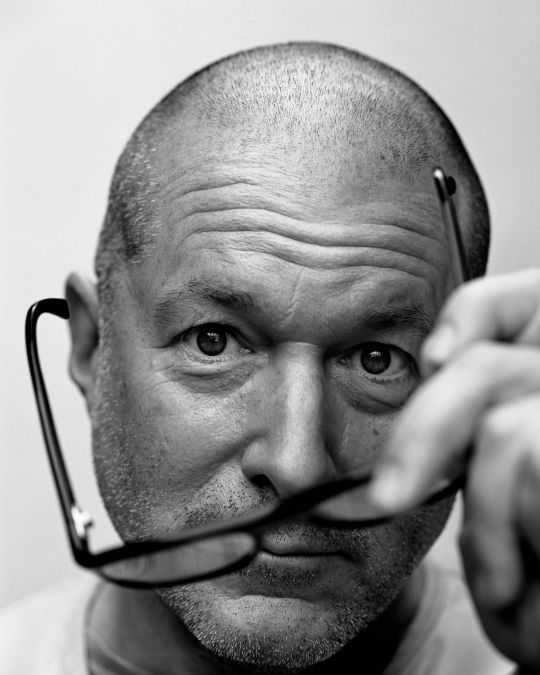
“Obsessive,” Ive calls himself, half joking. Entering his domain is like walking into a Gesamtkunstwerk (a German term for “total artwork”), something that arts and crafts movement founder William Morris might have created, but for a 21st-century Englishman who loves music, French-inspired gardens, Zen Buddhism and classic cars. One gets the sense that Ive created the space in part to prevent the pain of seeing anything he might deem poor design. “It’s very good for thinking,” he says.
Sir Jony Ive—as of 2012, the Knight Commander of the Most Excellent Order of the British Empire—has his name on 1,628 U.S. patents, part of 14,000 he holds worldwide encompassing both software and hardware. During his time at Steve Jobs’s side, the designs that flowed from his pen spanned items as wide-ranging as Apple Store shopping bags, an oak display table and the company’s most-sold product, the iPhone. In Ive’s 55 years, he’s filled piles of sketchbooks with door handles, drills, landscape plans and AirPods, almost all with his trademark rounded corners, as though he wants to buffer the world against its harsher edges.
Examining those AirPods with Ive present is akin to discussing a hand-hewn sculpture with the artist. The rich snap of the magnetized top as the earbuds click into place inside their case is a feature he’d worked and reworked, along with the smoothly honed interior and the weight and the feel of the case in one’s palm. “I don’t know what I would do without magnets,” he says, with a laugh. By giving the case a function—charging the earphones—he knew users would be less likely to lose them. It’s not unlike the 19th-century picnic trunks he collects in which each fork, spoon, knife and glass nestles in a custom-made spot.
“[Jony] is a complete one-off,” says Deyan Sudjic, a writer and the director emeritus of London’s Design Museum, pointing out the millions of consumers who own Apple products. “No designer of the 21st century has reached more people with the effects of their work and the physical presence of their work…. Jony has tried to make this avalanche of [technological] change into a dignified, humanistic one,” Sudjic says. “In a world where we focus on screens and pixels but still need physical objects, he is fascinated by materials and cares a lot how people use things.”
One surprising thing about Ive’s approach is that conversation, rather than sketches, is how he often begins a project. Thinking—and then speaking about that thinking—is the raw material he works with. “Language is so powerful,” Ive says. “If [I say] I’m going to design a chair, think how dangerous that is. Because you’ve just said chair, you’ve just said no to a thousand ideas.
“This is where it gets exciting,” he says. “You have an idea—which is unproven and isn’t resolved, since a resolved idea is a product—and the only tangible thing about the idea are the problems. When someone says it’s not possible, and all you are being shown is why it’s not possible, you have to think and behave in a different way. [You have to say], from a place of courage, I believe it is possible.

“No designer of the 21st century has reached more people with the effects of their work and the physical presence of their work,” Deyan Sudjic, the director emeritus of London’s Design Museum, says of Ive. Apple’s former chief design officer is seen here in his studio, seated in front of “Apple” (1985), by Andy Warhol (Andy Warhol, “Apple,” 1985, from The Ads Portfolio, screenprint on Lenox Museum Board, 38 X 38 Inches, courtesy Of Ronald Feldman Gallery, New York, © The Andy Warhol Foundation for the Visual Arts/Artists Rights Society (Ars), New York/Ronald Feldman Gallery, New York).
Jonathan Ive was born in 1967 in a northeastern suburb of London, where modest brick and Victorian townhouses peter out as they edge onto Epping Forest, a narrow stretch of ancient woodland. His father, Michael Ive, was trained as a silversmith and taught design at a vocational high school in East London and later for university students at Middlesex Polytechnic in North London. Jony often followed his father around, presenting drawings for go-karts, tree houses or other design ideas for his review. Once a year, as a special treat, Ive was allowed to make anything he wanted at his father’s Middlesex workshop.
“I really struggled to read,” says Ive, who was happiest being left to daydream with a sketch pad or to watch his father at work. “Fairly early on, I was labeled and described as an unsuccessful student,” he remembers.
When Ive was a teenager, the family moved north to the British countryside. He suffered from a slight stutter that made him reluctant to speak and gave the impression he was shy. “I didn’t fit in,” he says. “People wanted to bully me.” But an imposing build—and the fact that he played rugby—kept would-be tormentors in check. In high school, he started dating a pretty blonde, Heather Pegg, who attended the same church.
Though Ive’s gifts as a draftsman made him a candidate for fine art school, he knew what he wanted: a spot at Newcastle Polytechnic, an industrial design school. For once, he stood out as a star pupil, embracing the strict principles of the Bauhaus as expressed by contemporary designers like Dieter Rams, who in the early ’60s had become chief design officer at Braun. Ive likewise focused on the honesty of materials and the intended function of an object. Before graduation, he and Heather were married, and went on to have twin sons, Charlie and Harry.
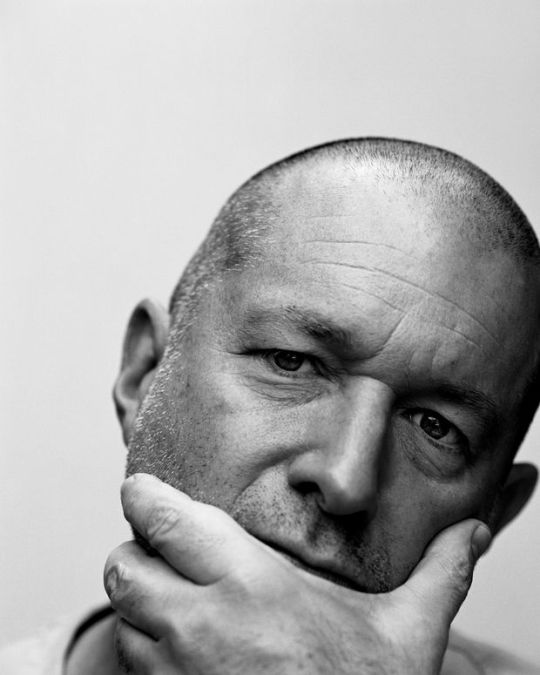
“Language is so powerful,” says Ive, who often begins a new project with conversation or writing, not sketches. “If [I say] I’m going to design a chair, think how dangerous that is. Because you’ve just said ‘chair,’ you’ve said no to a thousand ideas.”
Ive did well enough that upon leaving university in 1989 he earned an award that came with £500 (about $750 at the time), which he immediately spent on a plane ticket to San Francisco—a place he’d heard was a design utopia. Ive was wowed by the anything-is-possible atmosphere of Silicon Valley, which seemed like a polar opposite to conservative England. Upon his return to the U.K., he vowed to find a way back to San Francisco.
In 1990, Ive became a partner at a new agency in London, Tangerine. Tapped by Ideal Standard to develop ceramic bathroom designs, he did extensive historical research and created myriad prototypes, but his finished proposals were deemed too difficult to produce. The sense that he had wasted his time demoralised Ive. At around the same time, however, he was commissioned to design portable computers for Apple. It turned out to be an audition. In 1992, when he was 25, Ive was offered a job there.
“I love making things that are profoundly useful. I’m a very practical craftsperson.”
— Jony Ive
“I wanted to be a part of this crazy California company,” Ive says now. Corporation is a word he reviles. “A group of people who are truly united in a shared sense of purpose” is what he prefers, and that’s initially what he hoped to find at Apple. Instead, soon after he joined, the company began to drift. The Newton tablet he designed in 1992 was praised by critics but largely ignored by consumers. Apple started to atrophy into an acquisition target. “The most important lessons you would never choose to learn because they are so painful,” Ive says. “The death of a company is so ugly.”
Ive, now head of industrial design, felt his sense of purpose being stripped from him. He toyed with the idea of leaving Apple. But then, on September 16, 1997, exactly 12 years after Steve Jobs had walked out the door to launch NeXT Inc., Jobs returned as CEO of Apple.
Ive, then 30, assumed Jobs would hire a more renowned designer to replace him, but something unexpected happened at their first meeting. “I clicked with Steve in a way that I had never before done with someone and never have since,” says Ive.
Soon the two were having near-daily lunches and Jobs was spending untold hours in the design studio, where he and Ive transformed ideas into tangible products, starting with the luminous turquoise iMac, launched in 1998. Jobs recognised that Ive’s design made something nerdy—a boxy desktop PC—into a symbol of carefree cool, an all-in-one design with a handle that made it more portable. The new iMac was a hit, and Apple went on to ship five million units by April 2001. The company was suddenly flush with success.

“When I look at Jony’s contribution at Apple, it’s not one product,” says Apple analyst Neil Cybart. “It’s the culture that he built.” Above: Ive’s own Apple products.
Ive’s role in the revival of Apple can’t be overstated, says current CEO Tim Cook, who was at the company during this era. Soon Ive’s control extended beyond the design studio into operations and production. Always a perfectionist, Ive traveled to Apple factories in Taiwan, China, South Korea and Singapore, sometimes sleeping on the line to ensure the precision he brought to one-off samples had been captured in the final product. In 2001, Ive helped launch the iPod with its trademark white headphones, and later the ultra-slender MacBook Air (2008) and iPad (2010).
And the iPhone, which in 2007 did away with a keyboard in favour of an oversize screen that Ive had fought for—a slimmer version of the iPod but with vastly expanded functionality. The glossy, multitouch screen, now widely copied by other smartphones, ushered in a new era of communication that put a mini computer in everyone’s pocket.
Newson, who had designed a mobile phone in 2003 for Japanese company KDDI and knew the challenges of such a project intimately, recalls Ive showing him an example of that first iPhone. Newson was then holed up in a Swiss chalet with his wife and newborn daughter, and the rectangular iPhone, with its glass screen and Ive’s signature geometry based on Bézier curves, seemed like an omen from the future. “This was groundbreaking,” says Newson. “Game changing.”
During this time, since 2003, Jobs had been secretly battling pancreatic cancer, which would eventually take his life in October 2011. Ive was there with Cook; Jobs’s wife, Laurene Powell Jobs ; and their children on the day that Jobs died at home. “I feel the burden of being so fortunate having spent so much time with Steve,” Ive says now.
After Jobs’s death and Cook’s anointment as CEO, Ive pushed for projects he thought would take the company into the future: wearable technology, including Apple Watch and AirPods. Ive believed the watch would aid people in myriad ways—particularly in the area of health, by helping to identify irregular heartbeats or other indicators of ill health. When it was released in 2015, some critics disliked the limited battery life, but in the seven years since, Apple says, it has become the bestselling watch in the world. “It’s not really a watch—it’s taking the form of something familiar to people, centuries of wristwatches,” says Sudjic. “It shows an understanding of the way we relate to the things we wear.”
By 2017, Ive was Apple’s chief design officer when his ultimate project was unveiled: Apple Park, the company’s new headquarters in Cupertino, which he’d begun with Jobs and Norman Foster and finished with the architect and his firm Foster + Partners. The main building, an immense ring, strives to create ease of movement and communication across departments.
“It’s the biggest product that ever could be,” says Neil Cybart, founder of the Apple analysis site Above Avalon. “It’s meant to be a product that will make it easier to make other products in the future, by aiding the process of collaboration…. When I look at Jony’s contribution to Apple, it’s not one product. It’s the culture that he built—the process that he developed that Apple now uses. Interesting things come from the pursuit of perfection.”
At LoveFrom—the San Francisco–based creative collective that Ive co-founded with Newson in 2019—the offices are tiny compared to Apple Park but just as open. (Ive resigned from Apple the same year he started the company, saying he felt a responsibility to do something significant and make use of what he’d learned to solve new problems.) No dividing walls cut up the space. The office is abuzz with conversations that sometimes continue at Ive’s office-away-from-his-office, the twin restaurants Cotogna and Quince. Vestiges of Apple’s secrecy around releases remain, with samples—either made for clients or for products that Ive may introduce independently—shrouded under custom suede covers.

Ive with the Leica camera prototype he and Marc Newson made for the 2013 (RED) auction.
One of the first employees hired by Ive was a full-time writer. (There are now more than 30 employees, many of whom worked with him at Apple.) Ive says LoveFrom is the only creative practice he knows of to have an on-staff scribe whose job is, in part, to help conjure into words the ideas that his team of graphic designers, architects, sound engineers and industrial designers come up with for its collaborations with Airbnb, Ferrari and others.
“I think people think of design as how something looks. But that’s a superficial definition—it’s how something works,” says Airbnb co-founder Brian Chesky, who says he called Ive as soon as he saw his resignation announcement from Apple and asked to be one of LoveFrom’s first clients. Chesky, who studied at the Rhode Island School of Design, adds, “I always thought I knew about design, but I never understood design on a deeper level until I worked with Jony.” Ive is able to meld classic analog design with techy ideas about user experience and interface design—more typically the province of engineers, he says. Chesky and Ive speak almost daily, a practice they began during the pandemic, when Airbnb’s bookings dropped 80 percent.
When the company faced cuts, Ive advised Chesky to proceed cautiously: “You aren’t going to cut your way to innovation,” he said. Instead, one of the ideas he pushed Chesky to develop was to think even bigger, including to move beyond the limitations of the reservation boxes on the Airbnb home page that read “Where” and “When.” Ive told Chesky that the company is about “connection.” The designer will often create white books for his clients filled with reams of references. One he gave to Chesky reads “Beyond Where and When.” Their work is ongoing, with Ive advising on everything from Airbnb’s logo to current strategy.
“I don’t know anything about business,” Ive demurs, but he abhors the current fascination with disruption. “I’m not interested in breaking things,” he says. “We have made a virtue out of destroying everything of value,” he says. “It’s associated with being successful and selling a company for money. But it’s too easy—in three weeks we could break everything.”
“It’s a dilemma for Jony. He is of the generation that believed that design should last and that it shouldn’t be replaced every year,” says Sudjic, “but now he is in the generation where technology is an unstoppable force. Is he leading it or is he following it? But that sense of skill and craftsmanship is vital to him.”
Ive is quick to look ahead. “Success is the enemy of curiosity,” he says. And for Ive, curiosity has taken on an almost moral or religious quality. “I am terrified and disgusted when people are absolutely without curiosity,” he says. “It’s at the root of so much social dysfunction and conflict…. Part of why I get so furious when people dismiss creativity is that [when] it’s an activity practiced in its most noble and collaborative form, it means a bunch of people who come together in an empathic and selfless way. What I have come to realise is that the process of creating with large groups of people is really hard and is also unbelievably powerful.”
0 notes
Text
The Marring of a Masterpiece
By Rose Kiev, December 29 2004 (IMDb)
To quote Tracy Chevalier, the originator of this pseudo-historical rubbish, "Girl with a Pearl Earring is a story about a painting and how it came into being". However, 'Girl with a Pearl Earring' is not a story about "a painting" as she put it; it is the title of a famous masterpiece that has been admired for over three centuries; the exquisite work of Dutch master Johannes Vermeer.
Unfortunately, the title "Girl with a Pearl Earring" was appropriated by Chevalier to serve as the title of what would have been, if not for the co-opted allure of the famed artist and his well known masterpiece, considered a run of the mill, garden variety historical romance; certainly nothing special. As many art historians fear, the transference of Chevalier's fabrication to the silver screen is sure to create misconceptions about the Vermeer legacy in the minds of those who are limited to the confines of contemporary awareness, that is, most of the population.
Chevalier apparently gained an edge in the writer's market by exploiting the fame and creative efforts of an artist who has long been dead and is therefore unable to defend himself or the members of his family against the negative characterisations concocted by this mediocre novelist. Director Peter Webber was quoted as saying, "Girl with a Pearl Earring was really inspired by the painting of the same name". Inspired? Doesn't he mean that the "painting of the same name" was practically stolen and painted over for posterity with Chevalier's 21st century glitter glue? The fact that Chevalier and others have made a killing by irresponsibly trashing the memory of Vermeer and the members of his family to create an erotically suggestive tale says a lot about our culture. All marketing and no integrity.
What did the Vermeer's family ever do to Chevalier to merit such post-mortem character assassination? They were merely related to the famous artist. One wonders how Chevalier would feel if she were likewise negatively depicted by some stranger after her death. Because the Vermeers were real persons who lived at one time, it is wrong to vilify them in fiction three centuries later. The central characters in Chevalier's novel are not, as Chevalier suggests, merely spun from scant memories of persons who were known to have lived at one time. Chevalier contradicts or ignores the known facts of Vermeer's life. By all accounts, his marriage to Catherina who he did in fact paint several times (in contrast to what is suggested in Chevalier's storyline that he never painted her because she did not understand or appreciate his work)was a happy marriage. By the way, the Vermeer's had only the one maid, Tanneke, whom Vermeer also used as a model for some of his work.
Chevalier defamed Vermeer's wife and family by crafting very unflattering and rather unimaginative character from their memory: Vermeer is the stereotypical brooding artist, his wife a vicious, ill-tempered, mean spirited, and jealous bitch. Catherina's demonic portrayal was obviously necessary as a literary device to justify and evoke sympathy for the illicit undertones in the relationship between Vermeer and the fictional Griet. Vermeer's daughter Cornelia was depicted as a child whose behavior is so pathologically anti-social, she would probably be judged today as a child at risk for growing up into a serial killer.
Come to think of it, while Ms. Chevalier's fictional ingénue surfaces as the only noble character in the entire story, her fictional renditions of the Vermeer family cast them as the horrid folks from which she must attempt to shield herself. So henceforth, as far as popular culture is concerned, Vermeer is trapped in a miserable marriage, his wife and daughter are cold hearted witches, his mother-in- law the head shrew, and his patron the most lecherous man in Delft!
The worst thing about the film version of "Girl with a Pearl Earring" however, is that the image that will appear in association with Vermeer's masterwork in the future, will be Scarlett Johansson's Griet. Hers is a performance that could only be described as vapid and which consists mainly of Johannson's perpetual look of dumb surprise, her mouth hanging open continually, which although was probably meant to be seductive, looks more a general lack of intelligence or a contrived expression of feigned innocence. She was supposedly demure but appeared more or less bovine. It was a face that I grew so tired of by the end of the film, that I dearly wished the wicked and capricious (per Chevalier's fictional interpretation) Catherina would have given it a good slap when she went all out in her tirade in the final scenes.
0 notes
Text
Walk of the Week: St Mullin's to Graiguenamanagh
By Christopher Somerville, April 09 2011 (Irish IND.)
The Norman lord who had a castle mound heaped up at St Mullin's, and a wooden-walled keep erected on top, intended the fortification to overlook the tidal limit of the River Barrow just below, a great place to extract tolls -- and to overawe the locals.
Castle, palisade, lord and tollhouse are long gone; the locals remain, and so does the motte, like a green suet pudding on a well-mown plate of grass. It's a fine place to scramble up for a panoramic view of the monastery founded by St Moling that made the name and fame of St Mullin's for close on a thousand years.
Girdled tightly inside a stone perimeter wall, weathered stubs of monastic buildings rise from a sea of ornate graveslabs and crucifixes like ruins in a fable. St Mullin's monastery is a remarkable sight, poignant in its death-like stillness and silence.
Looking down from the flat-topped motte, Jane and I let our imaginations supply the drifting smoke, scurry of lay workers and pacing of monks, crowing of cocks, barking of dogs and tolling of the church bells.
St Moling's life spanned almost the whole of the seventh century AD. He was a remarkable man, quite unlike most of the hermits who founded those early monasteries -- poorly educated men with fierce convictions in their heads and fish scales in their beards.
Moling was born a prince and ended up an archbishop. He was a poet and thinker, but also a man of his hands, who dug his own mile-long mill race, ground corn for anyone who asked him, and ferried folk across the Barrow on a raft he built himself. He managed to negotiate the abolition of taxes that were crushing the local peasantry.
The saint never knew the monastery's handsome abbey church, the ornate High Cross with its broad-faced crucified Christ, or the Round Tower, whose base stands alongside the abbey. All
these post-date him by many centuries. But the memory of the ferryman prince, the cures he wrought and the good he did in his long life are still well remembered around St Mullin's.
Jane and I spent an hour exploring the ruins. Then we went down to the River Barrow and turned upstream along the towpath, following the puddled track of the Barrow Way. The day was starting cloudy and thick, with drifting mist through the valley, so that the summit of Brandon Hill, when it appeared at last rolling free of the vapour beyond the river, seemed a slate-grey leviathan breaking clear of a level white sea.
'Do not fish for salmon or sea trout,' admonished the notice by the keeper's cottage at St Mullin's lock, a reminder that here, 20 miles from the sea, the Barrow finally reaches its tidal limit.
Short sections of canal bypass weirs, complete with locks, white-tipped gates and neat lock-keepers' cottages in immaculate gardens.
A swiftly walking shape ahead on the path resolved itself into the trim, alert figure of Brian Gilsenan. We'd made friends on a Blackstairs ramble last year, and here he was coming down the Barrow to walk back to Graiguenamanagh with us.
The weirs across the Barrow roared and frothed, the copper-brown water moving with the implicit power of a big snake. The narrow grass causeway of the towpath separated the river, its overspill ditches where lichen-bearded hazels and willows stood up to their hips in swampy floodwater, a Co Carlow version of the Everglades.
A floody, half-drowned, misty landscape through which we tramped the bank upriver to Graiguenamanagh.
Beyond the beautiful old seven-arched bridge and partially restored warehouse quays of the town loomed the square bulk of Duiske Abbey.
Forbidding from the outside, what a revelation within -- a soaring interior, delicately carved embellishments, arches and columns so slender and fluted they seemed hardly fit for the purpose of holding up the great walls and the intricate, boat-like roof.
Duiske, the greatest Cistercian monastery in Ireland in its heyday, wielded a temporal power of which the rustic monks at St Mullin's could only have dreamed.
Now both foundations stand in humility, one roofless and empty, the other magnificently preserved, for walkers and wanderers to wonder at.
WAY TO GO
MAP:
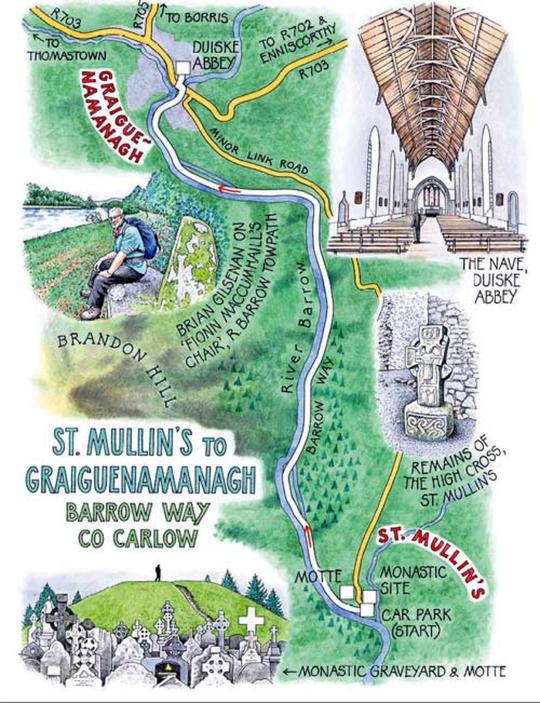
OS of Ireland Discovery Sheet 68. TRAVEL: R705 or R729 from Borris; R703 from Thomastown; R702 from Enniscorthy — all to Graiguenamanagh. Leave one car here; drive other car to St Mullin’s (minor road). Park in riverside car park below monastic site.
WALK DIRECTIONS:
From car park, uphill to explore St Mullin’s and monastic site; return to car park; right along River Barrow towpath (‘Barrow Way’) for four miles to Graiguenamanagh. LENGTH: 4½ miles. CONDITIONS: Level riverside path, can be wet and muddy.
REFRESHMENTS:
St Mullin’s: Blanchfields pub (00353 51 24745) or Mullicháin Café by river (11am-6pm, closed Mondays). Graiguenamanagh: Coffee On High café (00353 59 972 5725).
DON’T MISS:
Saint Mullin’s monastic site; view of Brandon Hill from the riverbank; Duiske Abbey, Graiguenamanagh. INFORMATION: Barrow Way: tcs.ireland.ie/dataland/TCS Attachments/311_TheBarrow Way.pdf. Guided Walks: Contact Brian Gilsenan on 00353 53 937 7828/00353 86 838 6460; mosscottage ireland.com. TIC: Tullow Street, Carlow. Tel: 00353 59 913 1554; carlowtourism.com
0 notes
Text
What Exactly is a ‘Summer Kitchen’?
By Robert Khederian, June 22 2017 (Curbed)

A little while back, while falling down a Zillow rabbit hole, we happened across a late-1700s eyebrow colonial a stone’s throw from the Hudson River. On the property was something we had rarely seen before: an intact "summer kitchen."
Sitting towards the back of the property, the low-profile brick-and-stone structure has a wood door and a stout chimney. The listing provided no interior photos, but there was mention of a fireplace (which, we’ll note, one could have easily surmised from the presence of the chimney).
We were suddenly overcome with curiosity about the origins of these small structures, how they were built, and if they were truly, as their name implies, only used during the summer. We set out for some answers.
Used primarily in the late-18th and early-19th centuries (though exceptions can be found), the summer kitchen had a number of practical applications in residential life. At its most basic level, the outbuilding physically separated hot kitchen activities from the rest of the house during the warmer months—a key way to survive the summer before the advent of modern air conditioning.
"Often, people would disassemble their coal or wood cookstove and move it into the summer kitchen when the weather got hot," says Nancy Carlisle, senior curator at Historic New England and co-author of America’s Kitchens. "It was all an effort to keep the house as cool as possible."
The summer kitchen also helped to keep cooking smells away from the main living areas of the house. But even more than that, the physical separation of a lit stove or hearth from the primarily wooden house meant that summer kitchens also reduced the risk of house fires. Notice how the summer kitchen in the listing photo is stone while the house wood frame—that difference of material is not an accident, and was likely influenced by the threat of fire.
In our conversation with Carlisle, she noted that in addition to being an auxiliary space for cooking, summer kitchens could also serve as a year-round location to do smelly chores like laundry.
While we’re no strangers to the idea of the kitchen being distinct from the rest of the house—it was a fairly common practice in the Gilded age—the separation of these seasonal kitchens from the main house does not necessarily signal a wealthy household. "Summer kitchens can be found in any type of house, from grand to modest," said Carlisle.
While summer kitchens are primarily found in upstate New York and the Midwest, 18th-century houses in the mid-Atlantic region—like Virginia—often separated the kitchen in a distinct, usually wooden, structure. Unlike summer kitchens of the north, these discrete workspaces were the main kitchens and were used year round rather than seasonally.
The separate kitchen structures of the mid-Atlantic region, which were used by enslaved workers, also held social significance, as it physically separated the enslaved in a space that often was capped by sleeping quarters in its attic. "The new kitchen architecture [of 18th century Williamsburg, Virginia] suddenly had little to do with cooking and everything to do with gender, race, and social space," writes Michael Olmert, Professor at University of Maryland in his essay "Kitchens: Places Apart."
Inside these kitchens of the 18th century—be they seasonal or not—little would actually signify the space as, well, a kitchen—at least to modern-day dwellers. "The whole notion of a kitchen with purpose-built cabinetry and countertops is very modern," said Carlisle. "We don’t see kitchens like the ones we’re used to until after 1930."
It's not unreasonable to draw the conclusion that summer kitchens were set up similarly to the kitchen in the main house. The space was kept quite clear, usually featuring a table pushed against the wall that could be used as either a workspace or a regular kitchen table. There may have been a rack for drying clothes or herbs, but the majority of the furnishings in the space would be entirely portable and temporary.
Food would be prepped in the kitchen, but it would not be stored there. "Herbs could be dried in the attic, flour and vegetables could be kept in a cool cellar—you could be traveling all around the house in order to assemble the ingredients for the evening’s meal," said Carlisle of food production in the late-18th and early 19th centuries. There wouldn’t even be a sink. Instead, water would be brought in and any washing would be done in a wooden barrel that could be emptied afterwards.
If the water needed to be heated, it would be done over the fireplace, one of the only elements of the kitchen built into the space. In houses of a certain age, the fireplace would be deep, practically a walk-in. But those fireplaces were wildly inefficient in their use of fuel, and were quickly switched out at the turn of the 19th century for a significantly more effective design by Count Rumford, a design that is shallow with widely splayed sides.
Aside from the fireplace, there may also be a bake oven directly to the right or to the left of the firebox. If you ever come across an older house with a fireplace that has an oven built next to it, chances are that room was once the kitchen of the house.
As summer kitchens exist today, though, they are completely obsolete. As kitchen technology changed, it no longer became necessary to move food preparation—and various unsightly chores—outside of the house. Although it
But while they now exist as a badge of historic honor on a real estate listing or as a quaint garden folly, we can't help but feel it would be kind of cool to have one of these culinary fossils in your backyard. If you restored it for recreational use, you’d almost be guaranteed to have the most unique cookout of the season.
3 notes
·
View notes
Text
Feeding Ducks Bread: Viral Sign Sparks Anger and Confusion
BBC, OCTOBER 18 2019

Does feeding bread to ducks help them or harm them?
A mysterious sign encouraging people to feed bread to "starving" ducks has stirred up confusion and angry debate about whether or not it is harmful.
The official-looking sign appeared in the Pavilion Gardens in Buxton, Derbyshire, but the park's managers insisted they were not responsible.
A mother who put a photo of the sign on Facebook was inundated with messages demanding she remove her post.
She has since deleted it, after the post was shared more than 17,000 times.
"I honestly thought I was doing a good deed," said Louisa Taylor.
"I have two young children so I really don't need the stress of it all."
The BBC asked various experts and they disagreed with each other too.

The sign appeared in Pavilion Gardens in Buxton, Derbyshire (UK), but has since been removed.
The photo - which was taken by one of Ms Taylor's friends - has appeared in thousands of Facebook timelines after being posted on multiple "Spotted" pages.
One commenter said: "How do people in this day and age still find it so difficult to do something as simple as feed ducks something other than bread!"
Another said: "Generations of people have fed ducks stale bread for years!! I see no decline in the duck population, just bloody feed them."
One woman said she and her husband were publicly told off by a stranger for feeding bread to ducks.
The photo has also been posted on Reddit with the title "I'm confused about duck diet now", and has had more than 39,000 upvotes.
'Quite confusing'
The woman who originally took the photo did not want to be named in this story because she feared a backlash for spreading incorrect information.
"There had been signs up the year before saying you can't feed bread to the ducks anymore, but then this sign was saying the ducks were dying and starving and I thought 'oh dear'," she said.
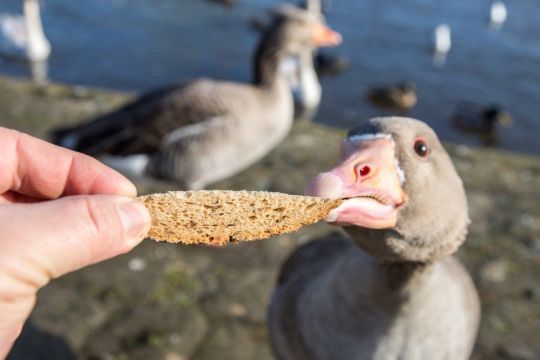
The RSPB said it was fine to feed water birds small amounts of bread.
What was the experts' advice?
'Bread isn't harmful'
The Royal Society for the Protection of Birds (RSPB) said it was fine to feed small amounts of bread to ducks but people should also feed them sweetcorn, porridge oats, peas and bird seed.
"Just like us, birds need a varied diet to stay healthy," said Tony Whitehead from the charity.
"Although ducks and swans can digest all types of bread, too much can leave them feeling full without giving them all of the important vitamins, minerals and nutrients they need.
"So, although bread isn't harmful, our advice is to only feed small amounts to birds."
'Excessive amounts of bird droppings'
Peter Birch: "Still too much bread is being dumped in the waterways"
The Canal and River Trust has campaigned against feeding bread to ducks, and has claimed it is "bad for ducks".
"Uneaten soggy bread can cause a build-up of bad nutrients which can lead to greater algal growth, spread disease and encourage pests such as rats," it said.
"It [feeding bread] also creates excessive amounts of bird droppings which, along with being smelly and slippery underfoot, can reduce water quality and clog waterways with harmful algae."
Ducks 'dying from starvation'
[VIDEO HERE MISSING]
A Berkshire charity says that misinformation has confused the public.
Swan Support, which rescues swans, ducks and geese, said many were starving because people had stopped feeding them bread in recent years.
They blamed a campaign called Ban the Bread, which was started by a company selling bird food.
"They wanted people to buy their food and that's where it all started," said Wendy Hermon from Swan Support.
"We were picking them up dying everywhere."
She said flocks of birds had become established in certain areas because of people feeding them and they had become reliant on this food supply.
"It's absolutely fine to feed bread. Bread has been fed to swans, ducks and geese for hundreds of years," she said.
However, she said people should only throw in as much as the birds ate, so there was no excess bread left behind to decay.
'It won't do them a lot of good'
Wild duck food maker Quack Snacks said while a "small amount of bread is unlikely to do ducks harm, it won't do them a lot of good either".
"There are alternatives to bread that contain more nutrients for waterfowl," said founder Andrew Hemmings.
"As lots of people enjoy feeding the ducks it is hard to avoid them having too much bread, so it would be much better if people offered something more nutritious and only did so in small amounts."
'Moderation is hard to judge'
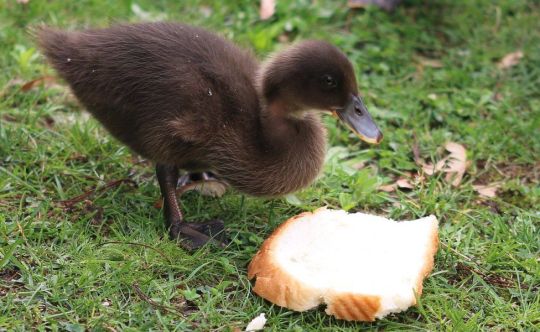
Young birds "Need to learn to forage for plants and insects."
The Wildfowl and Wetlands Trust said bread was "fine for water birds as long as it only forms a small part of their diet".
"Moderation is especially important in the spring and summer when an unbalanced diet can cause developmental problems for growing young birds," said Peter Morris.
"But moderation is hard to judge when other well-meaning people may also be feeding bread to the same birds at other times."
He said feeding birds vegetables, wheat grain and specialist food was safer and healthier. Winter was the best time to feed water birds, he said, when natural vegetation would be in short supply.
"Additional food is less vital in spring and summer, when young birds need to learn to forage for plants and insects, for a balanced diet and good physical development," he said.
0 notes
Text
No Great e-Reader Exists
Get a DVD case and hold it in your hands. A DVD case is nine inches measured diagonally. On any bookshelf you’ll be hard-pressed to find a smaller book. Pocket books are eight inches. Traditional paperbacks are 10.1 inches (digest) and 10.8 inches (US trade)¹. Hardcovers are larger. A DVD case should give you a good indication—it’s a nice size to hold in the hand. Given little-to-no bezels, perhaps narrower and taller digest is the perfect size and aspect-ratio? (photo below)²
A standard paperback-sized reader. Why? The idea is to closely mimic the traditional book reading experience, allowing for a larger display with an improved more open reading experience and a bigger battery with longer reading time between charges.
What I want is a virtually bezel-less electronic book reader purely for reading the size of a traditional paperback (10.1”). To hold the margins of the page with no page buttons in the way, like holding a real book. Kindles, like other e-readers have tiny displays and chunky bezels in addition to the page margins. They are devices for reading, but don’t celebrate the book reading experience.
No device bezels? So how do you page-forward, by tapping in the margin? What about unintentional page turns?
Pagination happens no matter where your hand is resting with a gentle squeeze using the pressure sensitivity function. Smart software ignores taps in any of the margins to prevent accidental page-turns or the need to lift your hand. Squeeze gently anywhere on the margin where your hand might naturally hold the reader. Down the bottom if you hold it that way. Up top… all four margins work. Right-hand; left-hand—no need to move your hand. Gentle press; next page.
Unintentional page turns—a thing of the past. Having to hold your reader a certain way to assist with turning pages—a thing of the past. Once you spend time with the device you really get a feel for how gently you can squeeze to page-forward. Tapping the middle of the page brings up your reading controls. If you prefer to turn pages by swiping across the display that works also. Should you need to revisit the prior page, just swipe in the opposite direction.
Page numbers—like a real book. Tapping on the current page number momentarily displays the total page-count in the book you’re reading (e.g. 32/296). That bigger number changes depending on the font type and font size you prefer. After some seconds the page number returns to that elegant clean look, in this example “32”. Once you know your book contains 296 pages you won’t have to keep checking constantly. Stop making e-Readers complicated and for geeks. Make one for those book readers who tell you they'll never use an e-Reader. Convince them and you’ve made a great e-Reader.
Decent speakers for optional text-to-speech, without need for an additional Bluetooth product to hear your book spoken aloud. High-impedance headphone jack offers the option of a high-quality headphone listening experience. Whenever available, audiobooks are bundled with e-Books. When the reader decides they want to hear their book spoken aloud a voice actor can pick up where they leave off allowing for a seamless transition from reading to listening. Latest Bluetooth. Latest Wifi. Latest USB-C. Wireless Qi charging. Power button.
Features not needed nor desired: handwritten note-taking or sketching; advanced stylus support; games (sry, Christina). iPad and other tablets are better for those tasks and paper is probably best for pure note-taking. People still use paper stickies and notebooks for a reason. Keyboard-written notes can be made on passages you might want to highlight. Dictionary definitions work as expected. An e-Reader need first be an e-Reader. Distractions, be gone!
We own many devices to play music. We don't need another. How about a web-browser? Jesus! We own phones and computers, we have enough web-browsers. And video? Believe it or not some readers on the market do in fact play video. Stop confusing the product—electronic book reader; zen; less is more. A coloured e-ink screen would be handy, so illustrations and book covers would be rendered in colour, but this would be cost dependant as colour e-ink is relatively new.
Native Mac/PC app can upload books wirelessly directly to your device in virtually any format. This process can also be achieved via USB-C cable and a wired connection. On-device book store has all the books available to sample or buy. Non-copyrighted classics are free. Non-copyrighted classics with audiobook spoken actor function cost.
Rear hardware shell is same colour as display. Is soft, curved, textured and comfortable, provides grip and does not show fingerprints or stain easily. Only branding is the name of the product subtly debossed in same colour on the back cover. Content is king: front of device has no bezel and thus no user-facing branding to distract from purpose of product—READING.
"Look, I’m holding the page. This is what you call an e-Reader.”
Someone make this product.


¹Publishing industry reference, reedsy.com:
“Trade paperbacks: The better-quality books you might pick up in a Barnes & Noble bookstore, trade paperbacks are probably what you picture when you think of a paperback book. Trade paperback sizes will range anywhere from 5.5 inches x 8.5 inches (a size that’s called digest; 10.1 inches diagonally) to six inches x nine inches (also known as US trade; 10.8 inches diagonally). In today’s market, this is the go-to paperback size range for many novels, memoirs, and non-fiction books. Hardcover: You’ll probably be familiar with these premium formats. These book sizes tend to range from six inches x nine inches to 8.5 inches x eleven inches.”
²Digest book size in the hand:
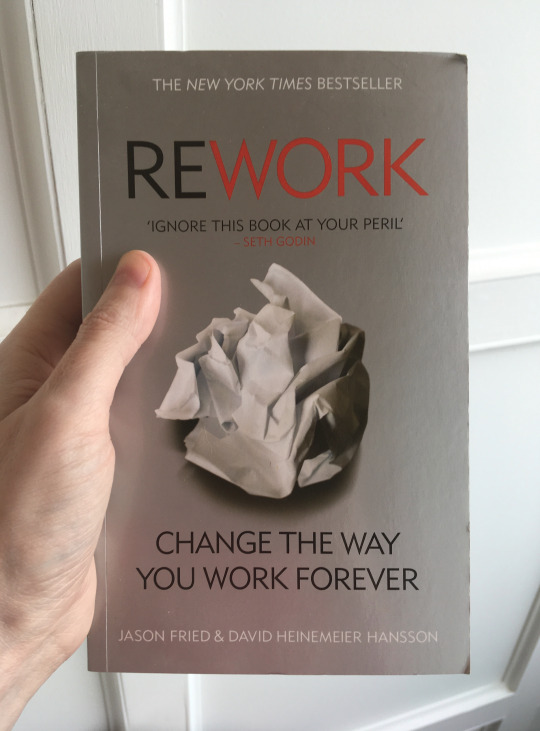
P.S. Kindle displays are too small at six to seven inches. Remember, even pocket books are eight inches. To some, the idea of having margins as your bezels may technically seem like a waste of a portion of the display, but nontechnically it's about the experience of reading a book.
0 notes
Text
Jessie Roestenberg's UFO Sighting (England)
Tony Roestenberg is a Dutch man, a solid, reliable type of man who settled in this country [UK] after World War II with his pretty Manx wife [from Manchester]. They set up house at Vicarage Farm, which is close to Ranton village in Staffordshire. It is a small cottage, partly half-timbered, partly whitewashed brick, set in rather lonely surroundings at the end of a bumpy track across a field. Stafford itself lies three and a half miles to the east and there Mr. Roestenberg works as an assistant architect. The young couple have three children, two boys and a girl, and until the advent of that exciting day in October, 1954, they were indistinguishable from any other happy little family.
Little Karin, their two-year-old daughter, played happily in her own tiny, exciting world and waited until her two brothers arrived home from school to join in her games. At 4.15 in they came, six-year-old Ronald, and Anthony, a bright youngster of eight.
Half-an-hour went by. Suddenly there came from outside a tremendous hissing noise— a noise as if a huge kettle were pouring water upon a mighty fire. Rushing out of the house, they were astounded to see a large object moving very low overhead, going southwards.
“It’s a jet!” cried one of the boys, and they all ran around to the other side of the house and looked in the direction that the object was going. There was nothing to be seen. Where had it gone? Bewildered, they looked up and their blood chilled when they realised why they could not see the object still moving across the sky. It was hovering over the house ! Very low and completely silent, a queer round thing was standing in the air immediately over the little cottage. It was no jet— it was a round saucer.
Brilliantly it shone in the sky, so low that they could make out every detail of its body. They could see that the upper part of the disc was revolving and the lower part stationary. Stationary above that aluminium-coloured disc was a dome, the back aluminium coloured but the front consisting of two transparent panels. With a Cath in her breath, Jessie Rostenberg saw that looking through those transparent panels at her were two men. They had tipped the Saucer slightly forward so that they could see downwards the better, and from this angle they silently regarded her.
She recalls that they looked very like earthly men, with white skins and long hair down to their shoulders. Their foreheads seemed immensely high, with the features almost entirely in the bottom half of their faces. Their heads were enclosed in what appeared to be some sort of transparent helmets and they were dressed in clothes of turquoise blue that resembled ski suits that Mrs. Roestenberg had seen. But what appeared strangest of all to the little group of watchers on the ground was the unsmiling expression on the faces of the men from the sky. Sternly they gazed down at the Roestenberg family, not in an unkindly fashion, but almost sadly, compassionately.
The terror of that little group can be imagined. They had only vaguely heard of Flying Saucers (their father had read a magazine article on the subject a year earlier) and the two boys had not read a space comic for months. Their heads were in a whirl. Who were these peculiar visitors and where had they come from ? They assumed immediately that they were not of this planet, and their fear, though momentary, was very great. The children flattened themselves on the ground, pressing themselves down against the cool, comforting earth, away from the menace that stared down at them from the skies. The dog, which had accompanied them into the garden at the first alarm, shot off howling down the track that led into the village. Yelping, he scudded along, impelled by the one thought of escaping from this strange thing that he could not under stand, away to the comforting sights and smells of the humans that he knew and loved.
As Jessie Rostenberg watched appalled, the craft began to move, flashing a purply-blue light from the front of it as it did so. At an angle of 45 degrees it started to ascend, making no sound as it moved, but continuing the flashing the whole time. With a gasp of relief Jessie ran into the house, intent on finding pencil and paper to sketch what she and the children had seen. As she looked for the stub of a pencil, the boys called out again from the garden. With fear returning once more to her heart she ran outside to sec the Saucer coming back again, this time from north to south. It circled the house in an anticlockwise direction one and a half times and then streaked skywards. It had gone at last. Mrs. Roestenberg had never seen anything go so fast. “It was going much faster than the fastest jet T have ever seen,” she told me later.
At the time of the sighting it had begun to get dark and the craft's trail — like that of a jet aircraft— showed like a shadowy pencil line against the blue of the sky. There was not a cloud in the heavens. Mrs. Roestenberg took one last look round and then ushered her children into the house to await the coming of her husband.
Mr. Roestenberg was absolutely astonished to hear his wife’s story, but the way in which it was told, the obvious terror of his children, the absence of the dog, the pencil sketch that Jessie had made of the craft, all convinced him that something very much out of the ordinary had happened in his absence and sent him hurrying to the police.
When they arrived they seem to have been very impressed by the story. One big constable rubbed hard at his head with his knuckles. “ Well,” he said, after a pause, “I never have believed in these here Flying Saucers, but I certainly do now".
The End.
*the author invented their own non-English word to describe the craft, so I fixed it.
0 notes